Let’s dive deep into the 30 Most Famous Nebulae.
The Pacman Nebula, The Carina Nebula, The Cocoon Nebula, The Ring Nebula, The Jellyfish Nebula, The Witch Head Nebula, The Thor’s Helmet Nebula, The Angel Nebula, The Rosette Nebula, The Helix Nebula, The Pencil Nebula, The Cat’s Eye Nebula, The Veil Nebula, The Eagle Nebula, The Running Man Nebula, The Cone Nebula, The Soul Nebula, The Lagoon Nebula, The Trifid Nebula, The North America Nebula, The Westerhout 40 (W40) Nebula, The Heart Nebula, The Tarantula Nebula, The Orion Nebula, The Crab Nebula, The Butterfly Nebula, The Blue Snowball Nebula, The Monkey Head Nebula, The Barn Owl Nebula, and The Boomerang Nebula.
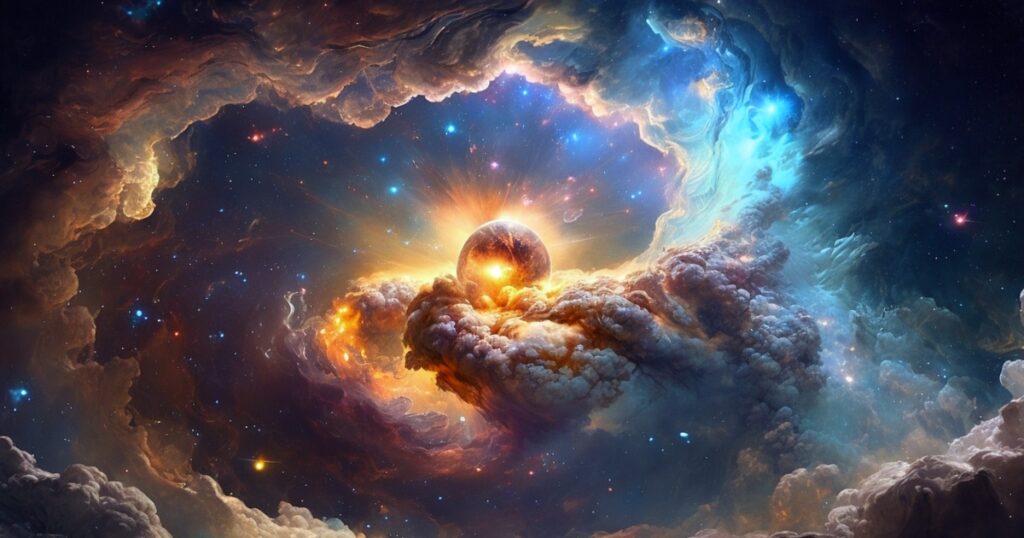
1. The Pacman Nebula:
The Pacman Nebula, also known as NGC 281 or IC 11, is a colorful emission nebula that resembles the iconic video game character Pac-Man. It is a large cloud of glowing gas and dust in the constellation Cassiopeia, where young stars are born.
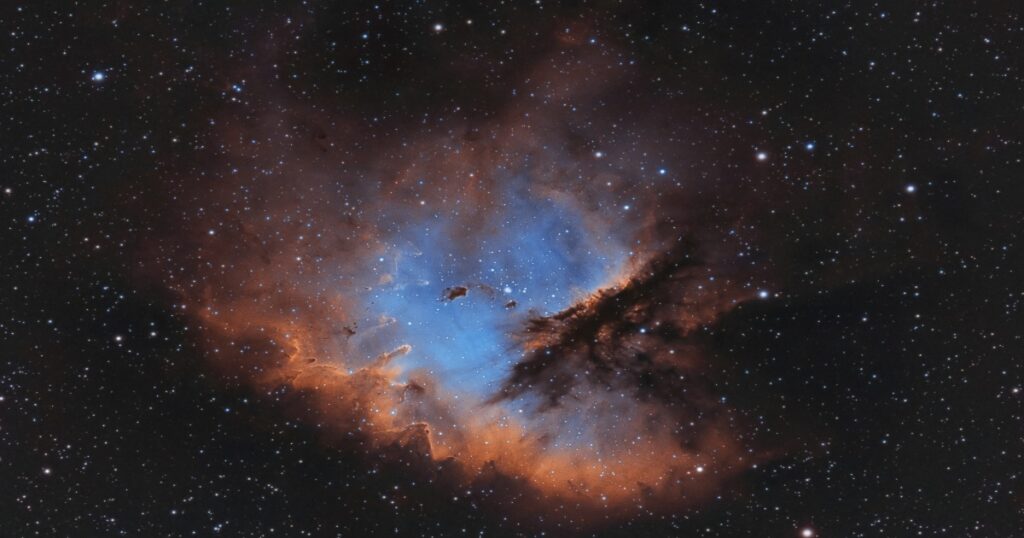
The Pacman Nebula’s Key Points:
Resemblance to Pac-Man: Pacman Nebula’s most recognizable feature is a dark lane of dust that creates the illusion of Pac-Man’s open mouth.
Star Formation: Hot, young stars within the embedded cluster IC 1590 energize the surrounding gas, causing the Pacman Nebula to glow.
Relatively Bright: Compared to other nebulae, the Pacman Nebula is bright enough for astrophotographers to capture stunning images.
The Pacman Nebula’s Discovery:
Pacman Nebula was discovered by American astronomer Edward Emerson Barnard in August 1883. He described it as “a large faint nebula, very diffuse.”
The Pacman Nebula’s Distance from Earth:
Pacman Nebula is approximately 6,500 light-years away from Earth in the constellation Cassiopeia (the Queen) in our Milky Way galaxy.
The Pacman Nebula’s Size:
The size of Pacman Nebula is roughly 30 light-years across.
The Pacman Nebula’s Formation:
The intense radiation and stellar winds from young stars in the embedded cluster IC 1590 ionize the surrounding hydrogen gas, making Pacman Nebula emit the vibrant light we see. Over time, these winds will erode the dust lane, slowly changing the Pacman’s iconic appearance.
The Pacman Nebula’s Iconic Feature:
The dark dust lane in the shape of Pac-Man’s open mouth, forever chasing the glowing gas clouds.
The Pacman Nebula’s Popularity:
Pacman Nebula is a favorite target for astrophotographers due to its unique resemblance to the video game character and its relative brightness.
The Pacman Nebula’s Recent Developments:
In 2012, astronomers using NASA‘s Wide-field Infrared Survey Explorer (WISE) revealed a more extensive view of the Pacman Nebula, showcasing its vastness in the infrared spectrum.
2. The Carina Nebula:
The Carina Nebula, also known as NGC 3372 or the Eta Carinae Nebula is an emission nebula, a colossal star-forming region located approximately 8,500 light-years away in the southern constellation Carina. It’s one of the largest and brightest nebulae in the sky.
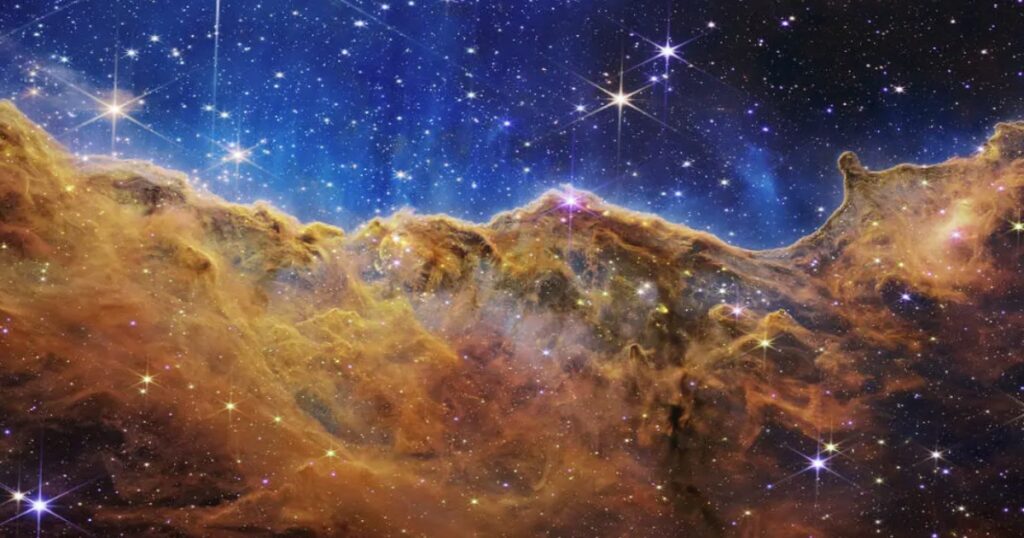
The Carina Nebula’s Key Points:
Grand Stellar Nursery: The Carina Nebula is a vast cloud of gas and dust actively birthing new stars, some far exceeding the Sun‘s mass.
Eta Carinae’s Drama: The Carina Nebula is home to the behemoth star Eta Carinae, known for its gigantic outburst in the 1840s, briefly becoming the second brightest star visible from Earth.
A Sculpted Canvas: The intense radiation and winds from young stars carve out dramatic shapes and pillars within the Carina Nebula.
Cosmic Cliffs Revealed: The James Webb Space Telescope captured unprecedented details of a young star-forming region within the Carina Nebula called the Cosmic Cliffs.
The Carina Nebula’s Discovery:
The exact date of discovery is a bit hazy. Early European explorers in the southern hemisphere likely spotted The Carina Nebula with the naked eye in the 16th or 17th century. The first documented observation is credited to French astronomer Nicolas-Louis de Lacaille in 1752 from South Africa.
The Carina Nebula’s Distance from Earth:
The Carina Nebula is a staggering 8,500 light-years away from Earth, located in the constellation Carina in our Milky Way galaxy.
The Carina Nebula’s Size:
The Carina Nebula is an enormous 230 light-years in diameter, dwarfing the famous Orion Nebula.
The Carina Nebula’s Formation:
Triggered by the shockwaves from a supernova explosion millions of years ago, the Carina Nebula is a vast cloud of gas and dust constantly birthing new stars. The intense radiation and stellar winds from these young stars carve out the nebula’s dramatic features.
The Carina Nebula’s Iconic Feature:
The Carina Nebula boasts a treasure trove of celestial wonders, but some of the most recognizable include:
Eta Carinae: A monstrous star, one of the most massive and luminous in our galaxy.
Keyhole Nebula: A dark nebula within the Carina Nebula with a distinctive keyhole-shaped opening.
The Carina Nebula’s Popularity:
Due to its location in the southern hemisphere, the Carina Nebula is less frequently observed by casual stargazers compared to objects in the north. However, its beauty and scientific significance make it a favorite among professional astronomers and astrophotographers who have access to southern skies.
The Carina Nebula’s Recent Developments:
The Carina Nebula was among the first targets for the James Webb Space Telescope. The telescope’s incredible resolution captured unprecedented details of the nebula, including the formation of new stars within the Cosmic Cliffs. This groundbreaking observation is revolutionizing our understanding of stellar birth processes.
3. The Cocoon Nebula:
The Cocoon Nebula, also known as IC 5146, is a fascinating celestial nursery where stars are born. It is a reflection and emission nebula located in the constellation Cygnus, approximately 3,262 light-years away. It’s a combination of glowing gas and dust where young stars are forming.
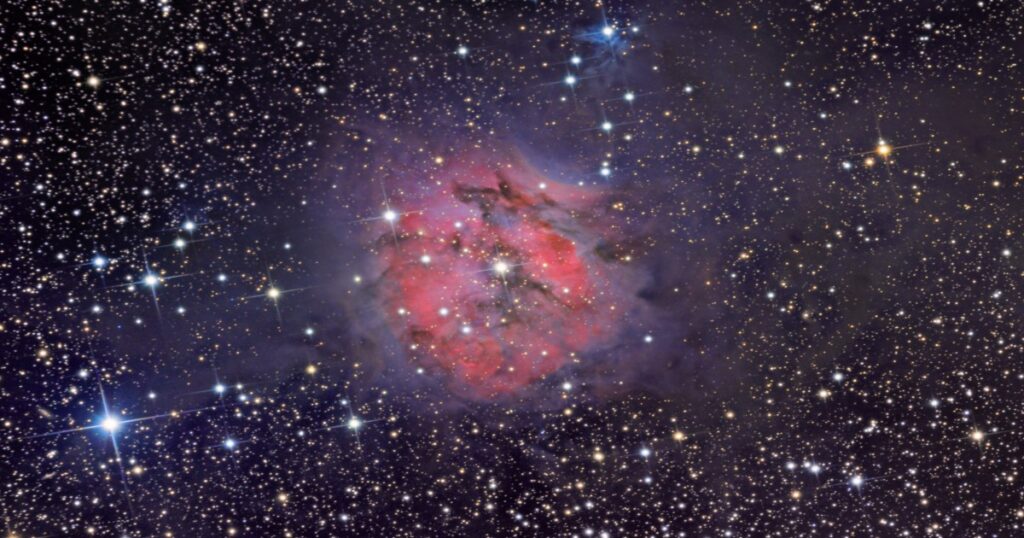
The Cocoon Nebula’s Key Points:
Starbirth in Action: The Cocoon Nebula is actively forming new stars, with a cluster of young stars called Collinder 470 at its heart.
Dusty Tapestry: Surrounding the Cocoon Nebula is a long tail of dark interstellar dust clouds, adding to its “cocoon” appearance.
Reflection and Emission: The Cocoon Nebula shines due to a combination of reflecting light from nearby stars and emitting its own light from ionized gas.
The Cocoon Nebula’s Discovery:
The Cocoon Nebula was discovered in 1894 by American astronomer William Henry Pickering.
The Cocoon Nebula’s Distance from Earth:
The Cocoon Nebula is approximately 3,262 light-years away from Earth in the constellation Cygnus in our Milky Way galaxy.
The Cocoon Nebula’s Size:
The Cocoon Nebula itself is relatively small, with an apparent size of around 12 arcminutes. However, the entire star-forming region is estimated to be 15 light-years in diameter.
The Cocoon Nebula’s Formation:
The Cocoon Nebula is believed to have formed from the collapse of a giant molecular cloud, a dense region of gas and dust in space. As the cloud collapses, gravity pulls material inwards, eventually igniting nuclear fusion and creating new stars.
The Cocoon Nebula’s Iconic Feature:
The long, dark dust lane that resembles the string closing a cocoon, giving The Cocoon Nebula its name.
The Cocoon Nebula’s Popularity:
While not as famous as some other nebulae, the Cocoon Nebula is a popular target for astrophotographers due to its relatively bright nature and interesting features.
The Cocoon Nebula’s Recent Developments:
Observations by space telescopes like Spitzer and Chandra have helped astronomers identify hundreds of young stellar objects within the Cocoon Nebula, providing valuable insights into the early stages of star formation.
4. The Ring Nebula:
The Ring Nebula, also known as Messier 57 (M57) or NGC 6720, is a breathtaking planetary nebula that resembles a glowing ring in the night sky. The Ring Nebula is a planetary nebula, the expanding shell of gas and dust ejected by a dying Sun-like star in its final stages of evolution.

The Ring Nebula’s Key Points:
Ghostly Beauty: The Ring Nebula is a symmetrical, expanding bubble of gas illuminated by the hot, faint central star.
Farewell Fireworks: The Ring Nebula formed during the final throes of a Sun-like star, as it casts off its outer layers before collapsing into a white dwarf.
A Look Back in Time: The light we see from the The Ring Nebula left thousands of years ago, giving us a glimpse into the star’s death throes.
The Ring Nebula’s Discovery:
The Ring Nebula was independently discovered by French astronomer Antoine Darquier de Pellepoix and Charles Messier in 1779 while observing a comet.
The Ring Nebula’s Distance from Earth:
The Ring Nebula is approximately 2,000 to 2,500 light-years away from Earth, located in the constellation Lyra in our Milky Way galaxy..
The Ring Nebula’s Size:
The Ring Nebula itself is roughly 1 light-year in diameter, with the central star at its heart.
The Ring Nebula’s Formation:
The Ring Nebula as a Sun-like star nears the end of its life, it runs out of fuel for nuclear fusion in its core. The core shrinks, causing the outer layers to expand and cool, eventually forming a planetary nebula. The intense ultraviolet radiation from the hot, exposed core then ionizes the gas in the nebula, causing it to glow.
The Ring Nebula’s Iconic Feature:
The distinct, almost perfectly circular ring shape, earning it the nickname “Ring Nebula”.
The Ring Nebula’s Popularity:
The Ring Nebula is one of the most famous and well-studied planetary nebulae due to its brightness, distinct shape, and relative proximity to Earth. It’s a popular target for both professional astronomers and amateur astrophotographers.
The Ring Nebula’s Recent Developments:
The James Webb Space Telescope recently captured the Ring Nebula in unprecedented detail, revealing intricate filaments and structures within the nebula. This data is helping astronomers gain a deeper understanding of the processes that occur during the death of Sun-like stars.
5. The Jellyfish Nebula:
IC 443, also known as the Jellyfish Nebula and Sharpless 248 (Sh2-248), is a captivating supernova remnant in the constellation Gemini. It is a supernova remnant (SNR), the expanding cloud of gas and dust left behind by a massive star’s explosion. IC 443 is a testament to the destructive and creative power of stellar evolution.

The Jellyfish Nebula’s Key Points:
Cosmic Jellyfish: The Jellyfish Nebula’s filamentary structure resembles the tentacles of a jellyfish, earning it its nickname.
Echoes of a Blast: The Jellyfish Nebula was formed by the violent explosion of a massive star thousands or tens of thousands of years ago.
Interacting with its Surroundings: The expanding shockwave from the supernova interacts with the surrounding molecular cloud, shaping the Jellyfish Nebula’s intricate filaments.
The Jellyfish Nebula’s Discovery:
The Jellyfish Nebula was cataloged in 1895 by the Index Catalogue (IC) compiled by Dreyer based on observations by John Dreyer.
The Jellyfish Nebula’s Distance from Earth:
The Jellyfish Nebula is roughly 5,000 light-years away from Earth, located in the constellation Gemini in our Milky Way galaxy.
The Jellyfish Nebula’s Size:
The Jellyfish Nebula is estimated to be approximately 70 light-years in diameter, though its faint and diffuse nature makes precise measurement challenging.
The Jellyfish Nebula’s Formation:
A massive star in the region reached the end of its life and underwent a core-collapse supernova. The explosion ejected the star’s outer layers into space, creating the expanding shell of gas and dust that forms the Jellyfish Nebula.
The Jellyfish Nebula’s Iconic Feature:
The Jellyfish Nebula, the long, wispy filaments that resemble a jellyfish’s tentacles, particularly evident in long-exposure astrophotography.
The Jellyfish Nebula’s Popularity:
The Jellyfish Nebula is a popular target for astrophotographers due to its unique structure and relatively large size. However, its faintness makes it challenging to observe visually.
The Jellyfish Nebula’s Recent Developments:
Data from NASA’s Chandra X-ray Observatory has revealed a possible neutron star (the collapsed core of the exploded star) at the edge of the Jellyfish Nebula, further solidifying the supernova origin theory. Astronomers are still debating the exact age of the remnant, with estimates ranging from a few thousand to tens of thousands of years.
6. The Witch Head Nebula:
C 2118, also known as the Witch Head Nebula or IC 2118, is a faint reflection nebula in the constellation Eridanus. It is a reflection nebula, a cloud of dust and gas that reflects light from nearby stars, causing it to glow faintly. In the case of C 2118, the illuminating star is the brilliant Rigel in Orion.

The Witch Head Nebula’s Key Points:
Spectral Silhouette: The dust in the Witch Head Nebula scatters blue light more efficiently than red light, creating a ghostly blue silhouette resembling a witch’s head in profile.
A Reflection of Rigel’s Light: The Witch Head Nebula’s faint glow originates from the intense light of the nearby supergiant star Rigel, located just below the nebula in the sky.
Part of a Larger Complex: C 2118 is situated within the Orion Molecular Cloud Complex, a vast star-forming region.
The Witch Head Nebula’s Discovery:
The exact date of the Witch Head Nebula’s discovery is uncertain. Early astronomers observing the Orion region might likely have noticed the faint nebulosity, but the first documented mention is attributed to the Index Catalogue (IC) compiled by Dreyer in the late 19th century.
The Witch Head Nebula’s Distance from Earth:
The Witch Head Nebula is estimated to be around 900 light-years away from Earth, located in the constellation Eridanus in our Milky Way galaxy.
The Witch Head Nebula’s Size:
The Witch Head Nebula itself is relatively small, with a diameter of approximately 50 light-years. However, it’s part of the much larger Orion Molecular Cloud Complex.
The Witch Head Nebula’s Formation:
The Witch Head Nebula is believed to be either a remnant of a supernova explosion or a cloud of gas and dust eroded by the powerful winds and radiation from nearby hot, young stars in the Orion region.
The Witch Head Nebula’s Iconic Feature:
The Witch Head Nebula, the faint, blue silhouette that resembles a witch’s head in profile, particularly noticeable in long-exposure astrophotography.
The Witch Head Nebula’s Popularity:
Due to its faintness, the Witch Head Nebula is not readily visible to the naked eye and is primarily studied and imaged by astrophotographers.
The Witch Head Nebula’s Recent Developments:
Observations with radio telescopes have revealed the presence of carbon monoxide within the Witch Head Nebula, indicating the existence of molecular clouds and potential ongoing star formation within the dusty envelope.
7. The Thor’s Helmet Nebula:
NGC 2359, aptly nicknamed Thor’s Helmet Nebula, is a captivating emission nebula in the constellation Canis Major. It is an emission nebula, a cloud of gas and dust where energetic young stars excite the surrounding atoms, causing them to glow. NGC 2359 is a stellar nursery teeming with activity.

The Thor’s Helmet Nebula’s Key Points:
A Fitting Name: The Thor’s Helmet Nebula’s shape resembles the mythological Norse god Thor’s helmet, with two wings flanking a central rounder region.
Winds of Change: The glowing gas in Thor’s Helmet Nebula is sculpted by the powerful stellar winds and radiation from the central star, WR7, a massive Wolf-Rayet star nearing the end of its life.
A Stellar Powerhouse: WR7 is a behemoth, many times more massive than the Sun, and its short but energetic life significantly impacts the surrounding Thor’s Helmet Nebula.
The Thor’s Helmet Nebula’s Discovery:
The exact date of the Thor’s Helmet Nebula’s discovery is a bit hazy. Early European explorers venturing into the southern hemisphere likely spotted it with the naked eye in the 16th or 17th century. The first documented observation is credited to French astronomer Nicolas-Louis de Lacaille in 1752 from South Africa.
The Thor’s Helmet Nebula’s Distance from Earth:
The Thor’s Helmet Nebula is approximately 11,970 light-years away from Earth, residing in the constellation Canis Major (The Greater Dog) in our Milky Way galaxy.
The Thor’s Helmet Nebula’s Size:
The Thor’s Helmet Nebula is roughly 30 light-years in diameter, though its faint nature makes precise measurement challenging.
The Thor’s Helmet Nebula’s Formation:
The Thor’s Helmet Nebula is believed to have formed from the collapse of a giant molecular cloud, a dense region of gas and dust in space. The intense radiation and stellar winds from WR7 then carved out the nebula’s distinctive features.
The Thor’s Helmet Nebula’s Iconic Feature:
The two prominent gas extensions resembling wings on either side of a central rounder region, give Thor’s Helmet Nebula the appearance of Thor’s mighty helmet.
The Thor’s Helmet Nebula’s Popularity:
Due to its location in the Milky Way plane and faintness, Thor’s Helmet Nebula is not readily visible to the naked eye and is a challenge for casual observers. However, it’s a popular target for astrophotographers with access to telescopes and dark skies.
The Thor’s Helmet Nebula’s Recent Developments:
Studies using radio and X-ray wavelengths are ongoing to determine the exact timeline of Thor’s Helmet Nebula’s formation and the influence of the massive WR7 star on its evolution. Astronomers are also interested in the possibility of additional star formation within the dusty regions of the nebula.
8. The Angel Nebula:
The Angel Nebula, also known as NGC 2170, is a breathtaking reflection nebula nestled within the vast Monoceros R2 molecular cloud complex in the constellation Monoceros (the Unicorn). It is a reflection nebula, a cloud of dust and gas that reflects light from nearby hot stars, causing it to appear to glow faintly. The Angel Nebula’s brilliance stems from the light of young, massive stars within the Monoceros R2 region.

The Angel Nebula’s Key Points:
Celestial Reflection: The Angel Nebula’s ethereal blue hues are a result of the dust preferentially scattering blue light from nearby stars.
A Stellar Neighborhood: The Angel Nebula resides within the Monoceros R2 giant molecular cloud, a star-forming factory teeming with young, energetic stars.
Sculpted by Starlight: The intense radiation and stellar winds from these young stars carve out intricate shapes and filaments within the Angel Nebula, adding to its beauty.
The Angel Nebula’s Discovery:
The Angel Nebula was discovered on October 16, 1784, by the renowned astronomer William Herschel.
The Angel Nebula’s Distance from Earth:
The Angel Nebula is approximately 2,700 light-years away from Earth, located in the constellation Monoceros (The Unicorn) in our Milky Way galaxy.
The Angel Nebula’s Size:
The Angel Nebula is relatively small compared to some nebulae, with an estimated angular diameter of approximately 2 arcminutes, a little less than halfway from Sirius to Bellatrix (another prominent star) in the night sky.
The Angel Nebula’s Formation:
The Angel Nebula likely formed from the same giant molecular cloud (Monoceros R2) that birthed the hot stars illuminating it. As the cloud collapsed under its own gravity, denser regions within it ignited nuclear fusion, becoming stars. The intense radiation and winds from these stars then interacted with the remaining dust and gas, creating the reflection nebula we see today.
The Angel Nebula’s Iconic Feature:
The ethereal blue glow and wispy structures within the Angel Nebula, resemble the wings of an angel, particularly in long-exposure astrophotography.
The Angel Nebula’s Popularity:
Due to its location in the southern celestial hemisphere and relatively faint nature, the Angel Nebula is not readily visible to the naked eye for most observers. However, it’s a favorite target for astrophotographers with access to telescopes and dark skies. Its beauty and association with star formation make it a captivating celestial object.
The Angel Nebula’s Recent Developments:
Observations with advanced telescopes like Spitzer and Hubble have provided astronomers with a deeper understanding of the star formation processes within the Monoceros R2 region. Studying the Angel Nebula allows scientists to piece together the story of how stars are born from the dusty cradle of giant molecular clouds.
9. The Rosette Nebula:
The Rosette Nebula, also known as Caldwell 49, is a magnificent star-forming region in the constellation Monoceros (the Unicorn). The Rosette Nebula is also known as the Skull Nebula due to its resemblance to a human skull. It is an emission nebula, a vast cloud of glowing gas and dust where young, hot stars excite the surrounding hydrogen atoms, causing them to emit their own light. The Rosette Nebula is a vibrant testament to stellar birth.

The Rosette Nebula’s Key Points:
A Stellar Flower: The Rosette Nebula’s most striking feature is its flower-like shape, with a central cluster of newborn stars surrounded by a ring of glowing gas and dust.
Starbirth Central: Home to a young open star cluster, NGC 2244, which formed from the Rosette Nebula’s material just a few million years ago. The intense radiation from these stars energizes the surrounding gas, causing it to glow.
A Sculpted Canvas: Stellar winds and radiation from the young stars erode and shape the Rosette Nebula, creating intricate filaments and pillars within its structure.
The Rosette Nebula’s Discovery:
The exact date of the Rosette Nebula’s discovery remains a bit fuzzy. Early European explorers venturing into the southern hemisphere likely spotted it with the naked eye in the 16th or 17th century. However, the first documented observation is credited to French astronomer Nicolas-Louis de Lacaille in 1752 from South Africa.
The Rosette Nebula’s Distance from Earth:
The Rosette Nebula is approximately 5,200 light-years away from Earth, located in the constellation Monoceros (The Unicorn) in our Milky Way galaxy.
The Rosette Nebula’s Size:
The Rosette Nebula is a colossal 130 light-years in diameter, dwarfing many other famous nebulae.
The Rosette Nebula’s Formation:
The Rosette Nebula is believed to have formed from the collapse of a giant molecular cloud, a dense region of gas and dust in space. As the cloud collapsed under its own gravity, denser regions within it ignited nuclear fusion, becoming stars. The intense radiation and winds from these young stars then interacted with the remaining dust and gas, creating the glowing nebula we see today.
The Rosette Nebula’s Iconic Feature:
The Rosette Nebula, a flower-like morphology with a central cluster and a surrounding ring of glowing gas and dust.
The Rosette Nebula’s Popularity:
The Rosette Nebula’s beauty and relative brightness in the northern hemisphere make it a popular target for astrophotographers and amateur astronomers. It’s a captivating example of a star-forming region teeming with life.
The Rosette Nebula’s Recent Developments:
Studies with advanced telescopes like Chandra and Hubble have revealed new details about the Rosette Nebula’s structure and the ongoing star formation within its dusty pockets. Astronomers are particularly interested in the young, massive stars at the nebula’s center and their influence on the surrounding environment.
10. The Helix Nebula:
The Helix Nebula, also known as NGC 7293 or Caldwell 63, is a planetary nebula, a beautiful shell of gas and dust ejected by a dying Sun-like star in its final throes of evolution.

The Helix Nebula’s Key Points:
A Cosmic Snail: The Helix Nebula’s most recognizable feature is its distinctive spiral or helix shape, resembling a giant snail shell.
Farewell Fireworks: The Helix Nebula was formed during the death throes of a Sun-like star, as it casts off its outer layers before collapsing into a white dwarf. The nebula’s glowing gas is a testament to this stellar fireworks display.
A Glimpse into the Past: The light we see from the Helix Nebula has traveled for thousands of years, offering us a chance to witness the final chapter of a star’s life.
The Helix Nebula’s Discovery:
The Helix Nebula was most likely discovered by Karl Ludwig Harding before 1824.
The Helix Nebula’s Distance from Earth:
The Helix Nebula is approximately 655 light-years away from Earth, residing in the constellation Aquarius (The Water Bearer) in our Milky Way galaxy.
The Helix Nebula’s Size:
The Helix Nebula is a vast 2.87 light-years in diameter, dwarfing many star systems.
The Helix Nebula’s Formation:
As a Sun-like star nears the end of its life, it runs out of fuel for nuclear fusion in its core. The core shrinks, causing the outer layers to expand and cool, eventually forming a planetary nebula. The intense ultraviolet radiation from the hot, exposed core then ionizes the gas in the Helix Nebula, causing it to glow.
The Helix Nebula’s Iconic Feature:
The Helix Nebula’s distinct, spiral-like shape, earned it the nickname “Helix Nebula.”
The Helix Nebula’s Popularity:
The Helix Nebula is one of the closest and brightest planetary nebulae, making it a popular target for both professional astronomers and amateur astrophotographers.
The Helix Nebula’s Recent Developments:
The James Webb Space Telescope recently captured the Helix Nebula in unprecedented detail, revealing intricate knots and structures within the nebula. This data is helping astronomers gain a deeper understanding of the processes that occur during the death of Sun-like stars.
11. The Pencil Nebula:
The Pencil Nebula, also known as NGC 2736, is a fascinating remnant of the Vela Supernova, the leftover gas and dust cloud following a massive star’s explosion. The Pencil Nebula showcases the dynamic aftermath of a supernova.
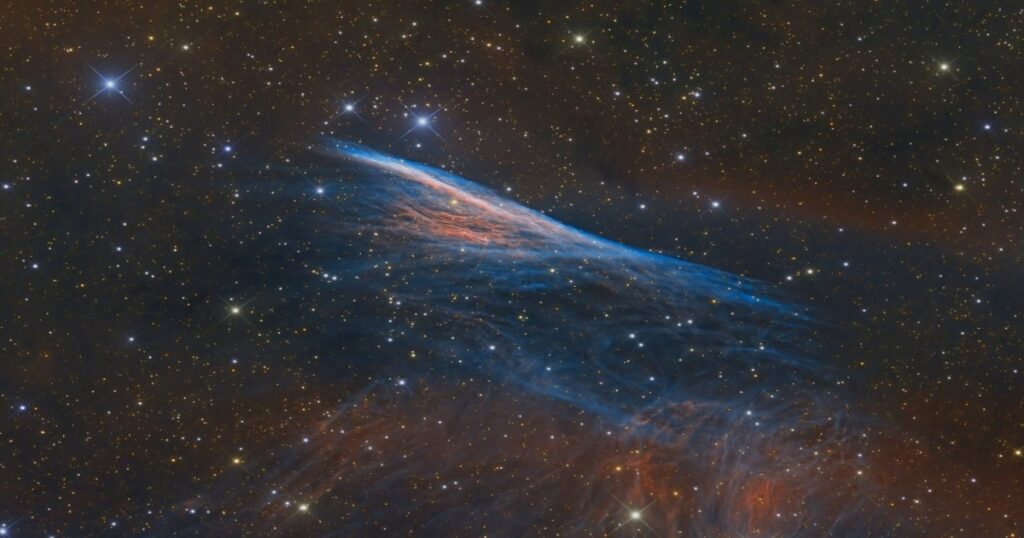
The Pencil Nebula’s Key Points:
Sharply Defined: The Pencil Nebula’s elongated, linear shape resembles a giant pencil lead streaking across the cosmic canvas, earning it its nickname.
Echoes of a Blast: Formed by the shockwave from a supernova that ripped through space thousands of years ago. The Pencil Nebula is a testament to the destructive and creative power of stellar death.
Interaction and Illumination: The bright eastern edge of the Pencil Nebula glows as the shockwave slams into denser material in the interstellar medium.
The Pencil Nebula’s Discovery:
The Pencil Nebula was discovered in 1835 by the renowned astronomer John Herschel while observing from South Africa.
The Pencil Nebula’s Distance from Earth:
The Pencil Nebula is roughly 815 light-years away from Earth, located in the constellation Vela (the Sails) in our Milky Way galaxy.
The Pencil Nebula’s Size:
The Pencil Nebula is relatively small compared to the vast Vela Supernova Remnant. The Pencil Nebula itself is roughly three-quarters of a light-year long.
The Pencil Nebula’s Formation:
A massive star in the region reached the end of its life and underwent a core-collapse supernova. The explosion ejected the star’s outer layers into space, creating the expanding Vela Supernova Remnant. The Pencil Nebula is a particularly bright and elongated section of the expanding shockwave from that explosion.
The Pencil Nebula’s Iconic Feature:
The Pencil Nebula, the sharp, linear shape resembling a giant pencil, especially prominent in long-exposure astrophotography.
The Pencil Nebula’s Popularity:
Due to its relatively faint nature, the Pencil Nebula is not readily visible to the naked eye. However, its unique shape and association with a supernova remnant make it a popular target for astrophotographers with access to telescopes.
The Pencil Nebula’s Recent Developments:
Studies using radio telescopes and X-ray observatories are helping astronomers map the structure of the Vela Supernova Remnant in more detail. These observations provide insights into the dynamics of supernova explosions and the impact they have on the surrounding interstellar medium. The Pencil Nebula is a valuable piece of the puzzle for understanding this energetic process.
12. The Cat’s Eye Nebula:
The Cat’s Eye Nebula, also known as NGC 6543 and Caldwell 6, is a captivating planetary nebula renowned for its intricate beauty. It is a planetary nebula, an expanding shell of gas and dust ejected by a dying Sun-like star in its final stages of evolution. The Cat’s Eye Nebula showcases the spectacular artistry of stellar death.
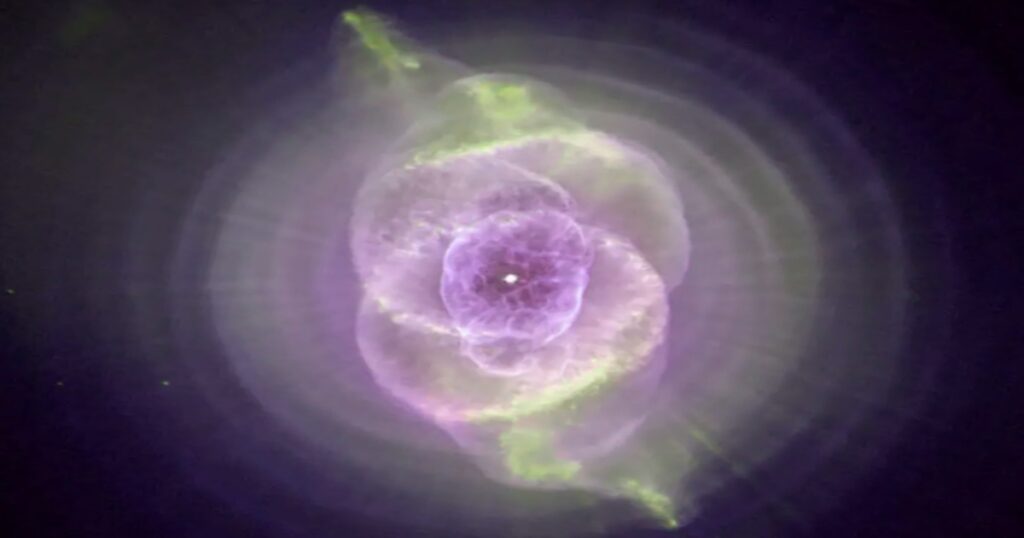
The Cat’s Eye Nebula’s Key Points:
A Jewel in the Sky: The Cat’s Eye Nebula’s most striking feature is its concentric shells of gas and dust, resembling a shimmering cat’s eye, earning it its nickname.
Farewell Symphony: Formed during the final throes of a Sun-like star, as it casts off its outer layers before collapsing into a white dwarf. The Cat’s Eye Nebula’s intricate structures are a testament to the complex processes involved in stellar death.
A Layered Legacy: Observations suggest the star ejected its mass in a series of pulses, creating the distinct, onion-like shells we see today.
The Cat’s Eye Nebula’s Discovery:
The Cat’s Eye Nebula was discovered by William Herschel on February 15, 1786, making it one of the first planetary nebulae to be identified.
The Cat’s Eye Nebula’s Distance from Earth:
The Cat’s Eye Nebula is approximately 3,262 light-years away from Earth, residing in the constellation Draco (the Dragon) in our Milky Way galaxy.
The Cat’s Eye Nebula’s Size:
The Cat’s Eye Nebula itself has a diameter of roughly 0.2 light-years, with the central star at its heart.
The Cat’s Eye Nebula’s Formation:
As a Sun-like star nears the end of its life, it runs out of fuel for nuclear fusion in its core. The core shrinks, causing the outer layers to expand and cool, eventually forming a planetary nebula. The Cat’s Eye Nebula’s unique, layered structure is likely due to the star ejecting its material in multiple pulses at different points in time. These shells are then illuminated by the intense ultraviolet radiation from the hot, exposed core.
The Cat’s Eye Nebula’s Iconic Feature:
The Cat’s Eye Nebula, the distinct, concentric shells of gas and dust, resembling a cat’s eye, particularly evident in long-exposure astrophotography.
The Cat’s Eye Nebula’s Popularity:
The Cat’s Eye Nebula’s brightness and captivating structure make it a popular target for both professional astronomers and amateur astrophotographers. It’s a valuable object for studying the final stages of stellar evolution.
The Cat’s Eye Nebula’s Recent Developments:
The James Webb Space Telescope recently captured the Cat’s Eye Nebula in unprecedented detail, revealing even fainter outer shells and intricate knots within the gas. This data is helping astronomers refine their understanding of the complex processes that shape planetary nebulae during stellar death.
13. The Veil Nebula:
The Veil Nebula (NGC 6969 or Sh2-49) also known as the Cygnus Loop (NGC 6960, NGC 6992, NGC 6995, IC 1340, NGC 6974, and NGC 6979), is a vast and breathtaking supernova remnant, a gigantic cloud of gas and dust leftover from the cataclysmic explosion of a massive star in the constellation Cygnus (the Swan).
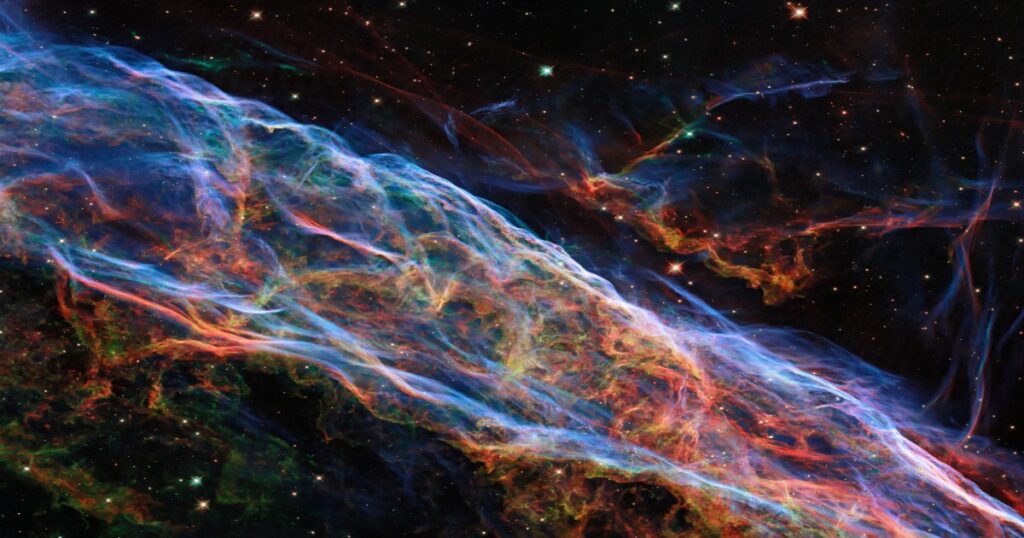
| Designation | Name | Description |
|---|---|---|
| NGC 6960 | Filamentary Nebula or Lacework Nebula | Bright, narrow nebula in the central to lower right, often seen with a prominent star (52 Cygni) nearby. |
| NGC 6974 & NGC 6979 | Pickering’s Triangle or Fleming’s Triangle | Luminous knots in a fainter patch of nebulosity along the northern rim. |
| NGC 6992 & NGC 6995 | Eastern Veil Nebula or Network Nebula | Brighter eastern section of the Veil Nebula. NGC 6992 forms the upper part, and NGC 6995 forms the lower part. |
| IC 1340 | Faint extension to the Eastern Veil Nebula | A faint, lower extension branching out from NGC 6995. |
The Veil Nebula’s Key Points:
A Cosmic Tapestry: The Veil Nebula’s most striking feature is its intricate network of glowing filaments, resembling a delicate veil draped across the night sky.
Echoes of a Supernova: Formed roughly 10,000 to 20,000 years ago when a massive star exploded, sending shockwaves and material hurtling into space. The Veil Nebula is the ever-expanding aftermath of this violent event.
A Sculpted Symphony: The shockwave from the supernova carved out the Veil Nebula’s intricate structures, interacting with and compressing the surrounding interstellar medium. This interaction creates a symphony of colors and textures within the nebula.
The Veil Nebula’s Discovery:
While the exact date of the Veil Nebula’s discovery remains unclear, early astronomers likely noticed the faint nebulosity with the naked eye. The first documented mentions are attributed to various catalog entries in the late 19th and early 20th centuries, including the NGC (New General Catalogue) and IC (Index Catalogue).
The Veil Nebula’s Distance from Earth:
The Veil Nebula is estimated to be around 1,470 to 2,100 light-years away from Earth, depending on the specific section of the nebula, located in the constellation Cygnus (The Swan) in our Milky Way galaxy.
The Veil Nebula’s Size:
The Veil Nebula is a colossal structure with an estimated diameter of 110 light-years. This makes it one of the largest supernova remnants known in our galaxy.
The Veil Nebula’s Formation:
A massive star in the Cygnus constellation reached the end of its life and underwent a core-collapse supernova. The explosion ejected the star’s outer layers into space at tremendous speeds, creating the expanding Veil Nebula. The shockwave continues to interact with the surrounding interstellar medium, shaping the nebula’s intricate filaments and features.
The Veil Nebula’s Iconic Feature:
The Veil Nebula, the vast network of glowing gas filaments, resembling a delicate veil or wispy fabric, particularly prominent in long-exposure astrophotography.
The Veil Nebula’s Popularity:
Due to its size and faintness, the Veil Nebula is not readily visible in its entirety to the naked eye. However, its various sections can be spotted by experienced observers under dark skies. The nebula’s beauty and scientific significance make it a popular target for astrophotographers and astronomers alike.
The Veil Nebula’s Recent Developments:
Advanced telescopes like Hubble and Spitzer have provided astronomers with detailed views of the Veil Nebula’s structure and composition. Studies continue to explore the shockwave dynamics, the impact on the surrounding environment, and the potential for ongoing star formation within the denser regions of the nebula.
14. The Eagle Nebula:
The Eagle Nebula (M16, NGC 6611) is a diffuse emission nebula, a young open cluster of stars nestled within the constellation Serpens. It’s a stellar nursery teeming with activity, and the birth pangs of new stars are evident in its most iconic feature, the majestic Pillars of Creation.
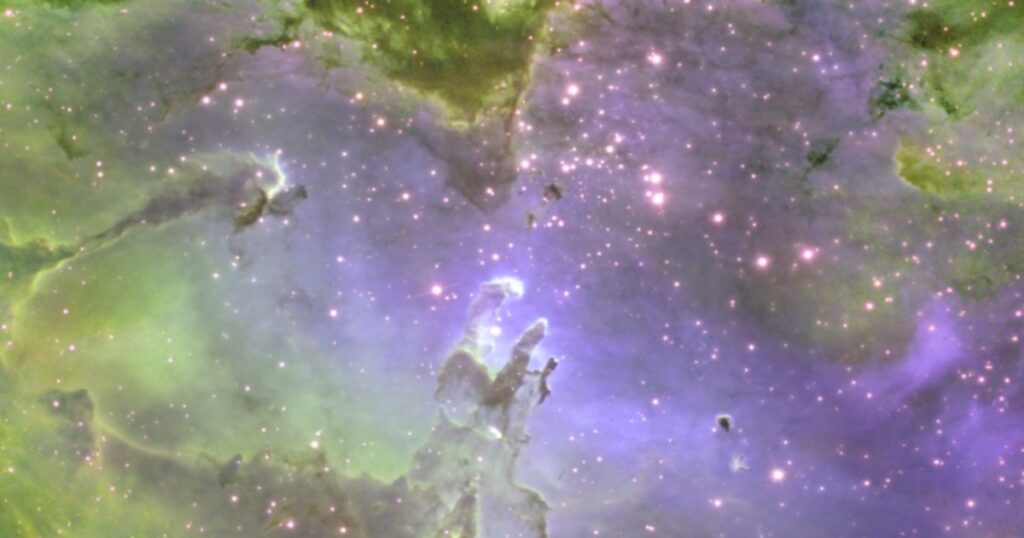
The Eagle Nebula’s Key Points:
Soaring Pillars: The Eagle Nebula’s most recognized feature is the Pillars of Creation, towering columns of gas and dust where young stars are cradled. These pillars are sculpted by the energetic winds and radiation from nearby hot stars.
A Starry Cradle: The Eagle Nebula is home to a vibrant young open cluster, stars just a few million years old. The intense light from these stars excites the surrounding gas, causing it to glow and illuminate the nebula’s intricate structures.
A Hatchery of Stars: The Eagle Nebula is an active star-forming region. Dense pockets within the nebula collapse under their own gravity, igniting nuclear fusion and giving birth to new stars.
The Eagle Nebula’s Discovery:
The Eagle Nebula was discovered in 1745-46 by Jean-Philippe de Cheseaux, a French astronomer.
The Eagle Nebula’s Distance from Earth:
The Eagle Nebula is approximately 7,000 light-years away from Earth, residing in the constellation Serpens (The Serpent) in our Milky Way galaxy.
The Eagle Nebula’s Size:
The Eagle Nebula itself stretches roughly 70 light-years across, while the Pillars of Creation are a few light-years in length.
The Eagle Nebula’s Formation:
The Eagle Nebula is believed to have formed from the collapse of a giant molecular cloud, a vast region of gas and dust in space. As the cloud collapsed under its own gravity, denser regions within it ignited nuclear fusion, becoming stars. The intense radiation and winds from these young stars then interacted with the remaining dust and gas, creating the nebula and sculpting the iconic Pillars of Creation.
The Eagle Nebula’s Iconic Feature:
The Pillars of Creation, towering columns of gas and dust where new stars are born. These pillars are a testament to the ongoing cycle of star birth and evolution within the Eagle Nebula.
The Eagle Nebula’s Popularity:
The Eagle Nebula’s beauty and the presence of the Pillars of Creation make it a popular target for professional astronomers and amateur astrophotographers alike. It’s a captivating glimpse into the birthplace of stars and a reminder of the dynamic processes at play in the universe.
The Eagle Nebula’s Recent Developments:
Advanced telescopes like Hubble and Spitzer have provided astronomers with detailed observations of the Eagle Nebula, revealing the complex processes within the Pillars of Creation and the ongoing birth of new stars.
15. The Running Man Nebula:
The Running Man Nebula (NGC 1977) is a reflection nebula, a cloud of dust and gas that reflects light from nearby hot stars, causing it to faintly glow. Its wispy blue tendrils resemble a figure in motion, earning it the name “Running Man Nebula”.

The Running Man Nebula’s Key Points:
Cosmic Jogger: The Running Man Nebula’s most striking feature is its resemblance to a running human figure, particularly evident in long-exposure astrophotography. The wispy blue gas and dust clouds create the illusion of limbs and a flowing form.
Celestial Spotlight: The Running Man Nebula’s faint glow originates from the reflection of light from the nearby star 42 Orionis. This energetic star illuminates the dust particles in the nebula, causing them to scatter blue light more efficiently.
A Shared Neighborhood: The Running Man Nebula resides within the vast Orion Molecular Cloud Complex, a star-forming factory teeming with young, hot stars. It shares this celestial space with its more famous neighbor, the Orion Nebula.
The Running Man Nebula’s Discovery:
The Running Man Nebula was discovered in 1786 by the renowned astronomer William Herschel.
The Running Man Nebula’s Distance from Earth:
The Running Man Nebula is approximately 1,460 light-years away from Earth, located in the constellation Orion in our Milky Way galaxy.
The Running Man Nebula’s Size:
The Running Man Nebula itself has a radius of roughly 7.5 light-years.
The Running Man Nebula’s Formation:
The Running Man Nebula likely formed from the same giant molecular cloud (Orion Molecular Cloud Complex) that birthed the hot stars illuminating it. As the cloud collapsed under its own gravity, denser regions within it ignited nuclear fusion, becoming stars. The intense radiation and winds from these young stars then interacted with the remaining dust and gas, creating the reflection nebula we see today.
The Running Man Nebula’s Iconic Feature:
The wispy, blue reflection, Running Man Nebula resembles a running human figure, particularly prominent in long-exposure astrophotography.
The Running Man Nebula’s Popularity:
Due to its relatively faint nature, the Running Man Nebula isn’t readily visible to the naked eye for most observers. However, it’s a favorite target for astrophotographers with access to telescopes and dark skies. Its unique shape and connection to the Orion star-forming region make it a captivating celestial object.
The Running Man Nebula’s Recent Developments:
Observations with advanced telescopes like Hubble and Spitzer have provided astronomers with a deeper understanding of the Orion Molecular Cloud Complex and the ongoing star formation within it. The Running Man Nebula offers a glimpse into the interplay between dust, gas, and young stars in this dynamic region.
16. The Cone Nebula:
The Cone Nebula (NGC 2264) is a fascinating combination of a dark nebula and an emission nebula nestled within the same celestial region. The dark nebula, the iconic cone shape, is a cold, dense cloud of dust and gas that blocks light from the stars behind it. Meanwhile, the emission nebula, a faint reddish glow surrounding the cone, is gas-ionized by nearby hot stars, causing it to emit its own light.

The Cone Nebula’s Key Points:
Cosmic Shadow: The Cone Nebula’s most striking feature is the dark cone, a towering structure resembling a light-year-long finger pointing into space. This dark nebula acts like a cosmic curtain, obscuring the light from background stars.
A Glowing Halo: The Cone Nebula, a faint reddish emission nebula surrounds the dark cone. This glow originates from the hydrogen gas in the region, energized by the ultraviolet radiation from nearby stars in the Christmas Tree Cluster.
Celestial Sculpting: The intense radiation and stellar winds from the hot stars in the Christmas Tree Cluster are slowly eroding the Cone Nebula, shaping its dramatic form.
The Cone Nebula’s Discovery:
The Cone Nebula was discovered on December 26, 1785, by the famed astronomer William Herschel.
The Cone Nebula’s Distance from Earth:
The Cone Nebula is approximately 2,700 light-years away from Earth, located in the constellation Monoceros (the Unicorn) in our Milky Way galaxy.
The Cone Nebula’s Size:
The Cone Nebula’s dark cone itself is roughly 7 light-years long, while the entire nebula complex (including the emission nebula) is even larger.
The Cone Nebula’s Formation:
The Cone Nebula likely formed from the collapse of a giant molecular cloud, a vast region of gas and dust in space. As the cloud collapsed under its own gravity, denser regions within it formed the dark nebula, while the surrounding gas was ionized by the intense radiation from nearby stars, creating the emission nebula.
The Cone Nebula’s Iconic Feature:
The Cone Nebula’s dark cone shape, a dramatic pillar silhouetted against the faint reddish glow of the emission nebula, particularly evident in long-exposure astrophotography.
The Cone Nebula’s Popularity:
While the faint emission nebula isn’t readily visible to the naked eye, the Cone Nebula’s unique shape and association with the Christmas Tree Cluster make it a popular target for astrophotographers with access to telescopes.
The Cone Nebula’s Recent Developments:
Studies with advanced telescopes like Spitzer and Hubble are helping astronomers understand the complex interplay between dust, gas, and young stars within the Monoceros R2 giant molecular cloud complex. The Cone Nebula offers valuable insights into the sculpting power of stellar radiation and the birth of new stars within these dusty clouds.
17. The Soul Nebula:
The Soul Nebula (IC 1845) is a captivating, but faint, emission nebula, a cloud of gas and dust where energetic young stars excite the surrounding atoms, causing them to glow faintly. The Soul Nebula’s ethereal glow is a testament to the ongoing star formation within Cassiopeia OB2. nestled within the vast Cassiopeia OB2 association, a stellar breeding ground in the constellation Cassiopeia.
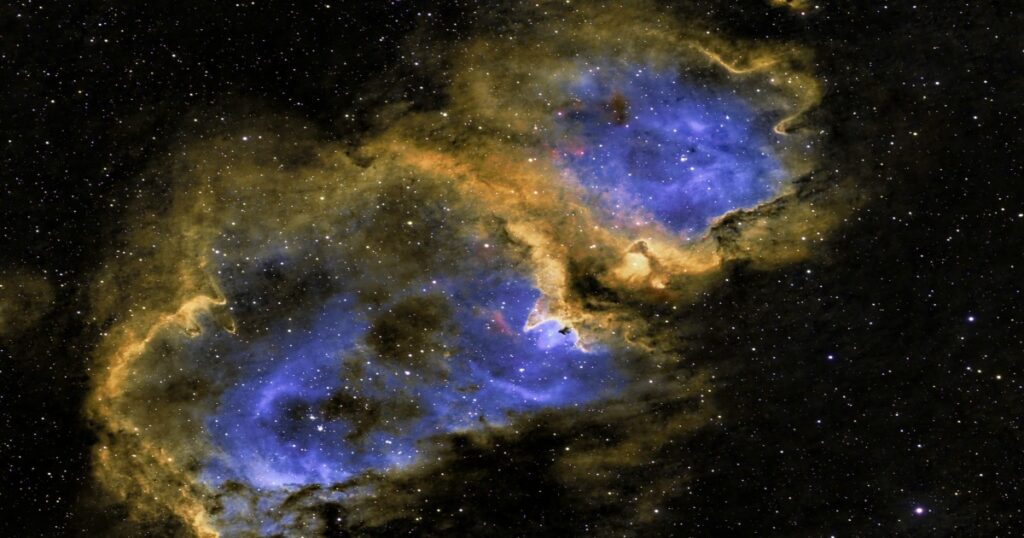
The Soul Nebula’s Key Points:
A Wispy Shroud: The Soul Nebula’s most recognizable feature is its faint, wispy structure, often described as S-shaped or resembling a ghostly apparition. This delicate appearance is why it earned the nickname “Soul Nebula”.
Starlight Symphony: The Soul Nebula’s faint glow originates from the energetic radiation from nearby hot, young stars in Cassiopeia OB2. This radiation excites the hydrogen gas in the nebula, causing it to emit a reddish hue.
A Shared Stellar Nursery: The Soul Nebula resides within the Cassiopeia OB2 association, a giant molecular cloud complex teeming with young, massive stars. The intense radiation and stellar winds from these stars play a crucial role in shaping the nebula and triggering further star formation.
The Soul Nebula’s Discovery:
The exact date of Soul Nebula’s discovery remains a bit hazy. Early European explorers venturing into the northern hemisphere likely spotted it with the naked eye in the 16th or 17th century. However, the first documented observation is credited to American astronomer Edward Emerson Barnard in 1894.
The Soul Nebula’s Distance from Earth:
The Soul Nebula is estimated to be roughly 2,000 to 3,000 light-years away from Earth, located in the constellation Cassiopeia in our Milky Way galaxy.
The Soul Nebula’s Size:
The Soul Nebula is relatively small compared to some nebulae, with an estimated diameter of a few light-years.
The Soul Nebula’s Formation:
The Soul Nebula likely formed from the collapse of a dense region within the Cassiopeia OB2 giant molecular cloud. As the cloud collapsed under its own gravity, the material became denser and hotter, eventually igniting nuclear fusion in some areas, forming stars. The intense radiation and stellar winds from these young stars then interacted with the remaining dust and gas, creating the emission nebula we see today.
The Soul Nebula’s Iconic Feature:
The Soul Nebula’s faint, wispy, S-shaped structure, often described as resembling a ghostly apparition, particularly prominent in long-exposure astrophotography.
The Soul Nebula’s Popularity:
Due to its faint nature, the Soul Nebula is not readily visible to the naked eye for most observers. However, its association with a star-forming region and its delicate beauty make it a favorite target for astrophotographers with access to telescopes and dark skies.
The Soul Nebula’s Recent Developments:
Advanced telescopes like Hubble and Spitzer are aiding astronomers in studying the dynamics of the Cassiopeia OB2 association and the ongoing star formation within its dusty clouds. The Soul Nebula offers a glimpse into the early stages of star formation and the delicate interplay between gas, dust, and young stars.
The Soul Nebula’s Bonus Note:
The Soul Nebula often appears alongside its more prominent neighbor, the Heart Nebula (IC 1805), in astrophotography. These two nebulae share the same celestial canvas, showcasing the diverse beauty of star-forming regions.
18. The Lagoon Nebula:
The Lagoon Nebula (M8, NGC 6523) is an emission nebula, a vibrant star-forming nebula. Imagine a swirling cloud of gas and dust, studded with bright young stars, all roughly 4,100 light-years away. This iconic nebula gets its name from its dark dust lanes that resemble a lagoon, showcasing the birth of stars amidst the cosmic dust.

The Lagoon Nebula’s Key Points:
A Cosmic Lagoon: The Lagoon Nebula’s most recognizable feature is its resemblance to a lagoon or a bird’s wing, with dark dust lanes creating a “lagoon-like” effect within the glowing gas.
Stellar Cradle: The Lagoon Nebula is home to a vibrant young open cluster (NGC 6530) embedded within its heart. The intense radiation from these stars excites the surrounding gas, causing it to glow brightly.
A Sculpting Symphony: The dark dust lanes within the Lagoon Nebula are sculpted by the energetic radiation and stellar winds from the young stars, creating a dramatic tapestry of light and shadow. These dark lanes also play a crucial role in ongoing star formation by providing dense pockets for material to collapse under its own gravity.
The Lagoon Nebula’s Discovery:
The Lagoon Nebula was discovered before 1654 by Giovanni Hodierna, an Italian astronomer. This makes it one of the only two star-forming nebulae faintly visible to the naked eye from mid-northern latitudes.
The Lagoon Nebula’s Distance from Earth:
The Lagoon Nebula is roughly 4,100 light-years away from Earth, residing in the constellation Sagittarius (The Archer) in our Milky Way galaxy.
The Lagoon Nebula’s Size:
The Lagoon Nebula is a vast nebula, stretching roughly 55 light-years long and 20 light-years wide.
The Lagoon Nebula’s Formation:
The Lagoon Nebula likely formed from the collapse of a giant molecular cloud, a vast region of gas and dust in space. As the cloud collapsed under its own gravity, denser regions within it ignited nuclear fusion, becoming stars. The intense radiation and stellar winds from these young stars then interacted with the remaining dust and gas, creating the nebula and shaping its filamentary structure.
The Lagoon Nebula’s Iconic Feature:
The Lagoon Nebula’s resemblance to a lagoon or a bird’s wing, with dark dust lanes contrasting against the glowing gas, particularly evident in long-exposure astrophotography.
The Lagoon Nebula’s Popularity:
Due to its relative brightness and association with star formation, the Lagoon Nebula is a popular target for both professional astronomers and amateur astrophotographers. It offers a captivating glimpse into the birth of stars and the dynamic processes at play within a stellar nursery.
The Lagoon Nebula’s Recent Developments:
Advanced telescopes like Hubble and Spitzer have provided astronomers with detailed observations of the Lagoon Nebula, revealing intricate structures within the nebula and the ongoing formation of new stars within the dense pockets. Studies continue to explore the impact of stellar winds and radiation on the nebula’s morphology and the potential for future generations of stars.
19. The Trifid Nebula:
The Trifid Nebula (M20, NGC 6514) is a captivating example of a celestial trifecta, a blend of emission nebula, reflection nebula, and dark nebula, showcasing a unique combination of gas and dust interactions.

The Trifid Nebula’s Key Points:
Threefold Beauty: The Trifid Nebula’s most striking feature is its trisected appearance, created by dark dust lanes obscuring the glowing gas behind them. This three-lobed structure earned it the name “Trifid Nebula.”
A Glowing Tapestry: The Trifid Nebula features a combination of emission and reflection nebulae. The reddish emission nebula originates from hot, young stars ionizing the surrounding hydrogen gas. Meanwhile, the blue reflection nebula reflects the light from these stars off dust particles.
A Sculpted Symphony: The dark nebulae (Barnard 85) act like cosmic curtains, blocking light from the background and creating a dramatic trifid appearance. The interplay between all these components results in a beautiful tapestry of colors and textures in the Trifid Nebula.
The Trifid Nebula’s Discovery:
The Trifid Nebula was discovered on June 5, 1764, by the renowned astronomer Charles Messier while compiling his famous Messier Catalog.
The Trifid Nebula’s Distance from Earth:
The Trifid Nebula is approximately 5,200 light-years away from Earth, residing in the constellation Sagittarius (The Archer) in our Milky Way galaxy.
The Trifid Nebula’s Size:
The Trifid Nebula itself stretches roughly 21 light-years in radius, with the dark nebulae contributing significantly to its overall size.
The Trifid Nebula’s Formation:
The Trifid Nebula likely formed from the collapse of a giant molecular cloud. As the cloud collapsed under its own gravity, denser regions ignited nuclear fusion, becoming stars. The intense radiation and stellar winds from these young stars then interacted with the remaining dust and gas, creating the emission and reflection nebulae we see today. Denser pockets within the cloud also remained unilluminated, forming the dark nebulae.
The Trifid Nebula’s Iconic Feature:
The Trifid Nebula’s trisected appearance caused by dark dust lanes (Barnard 85) obscuring the glowing gas behind them, particularly evident in long-exposure astrophotography.
The Trifid Nebula’s Popularity:
Due to its relative brightness and unique structure, the Trifid Nebula is a popular target for both professional astronomers and amateur astrophotographers. It offers a captivating glimpse into the diverse processes at play within star-forming regions.
The Trifid Nebula’s Recent Developments:
Advanced telescopes like Hubble and Spitzer have provided astronomers with detailed observations of the Trifid Nebula, revealing the complex interplay between gas, dust, and young stars. Studies continue to explore the dynamics of star formation within the nebula and the impact of the dark nebulae on the overall structure and evolution.
20. The North America Nebula:
The North America Nebula (NGC 7000, Caldwell 20) is a captivating reflection nebula, a cloud of dust and gas that reflects light from nearby stars, causing it to faintly glow and showcase the characteristic shape for which it’s named, famed for its uncanny resemblance to North America continent.
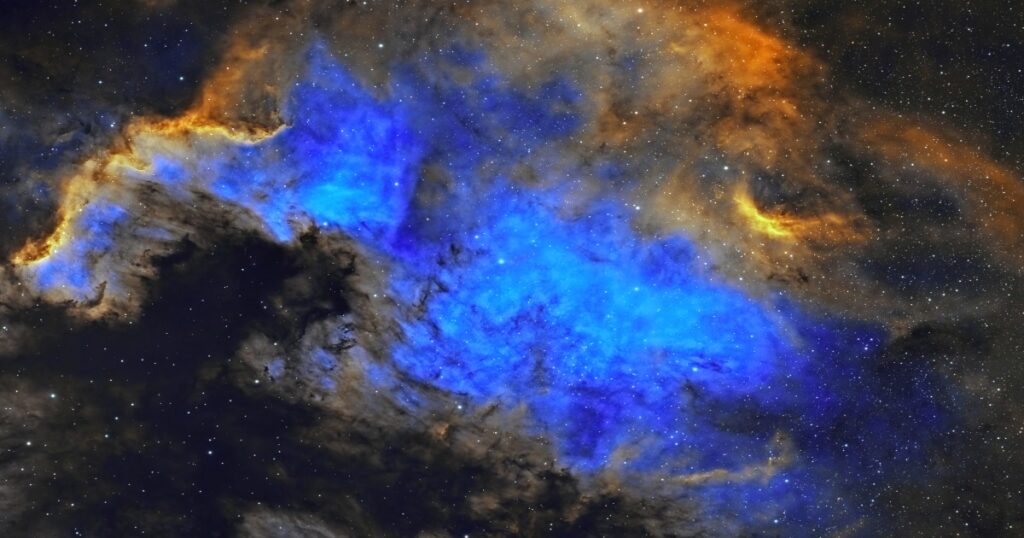
The North America Nebula’s Key Points:
Continental Kinship: The North America Nebula’s most striking feature is its resemblance to the continent of North America, complete with a glowing “Gulf of Mexico” region. This resemblance is what earned it the nickname “North America Nebula.”
Reflected Glory: The North America Nebula doesn’t emit its own light. Instead, it reflects the light from the hot, young star Deneb (located in the constellation Cygnus, the Swan). The dust particles within the nebula scatter the blue light from Deneb more efficiently, creating the overall blue hue.
A Shared Celestial Neighborhood: The North America Nebula resides within a larger complex known as Sharpless 2-117. Its neighbor, the Pelican Nebula (IC 5070), shares the same illuminating star (Deneb) and appears connected in long-exposure astrophotography, although they are separated by a vast gulf of dark dust.
The North America Nebula’s Discovery:
Partially Unveiled: The faint nebulosity in this region was first noted by William Herschel in 1786. However, The North America Nebula wasn’t cataloged as a distinct nebula until his son, John Herschel, observed it in 1829.
The “North America” Recognition: The nebula’s distinct shape was recognized much later, in 1890, by German astronomer Max Wolf, who captured it in a long-exposure photograph and christened it the “North America Nebula.”
The North America Nebula’s Distance:
The North America Nebula is approximately 2,202 light-years away from Earth, residing in the constellation Cygnus (the Swan) in our Milky Way galaxy.
The North America Nebula’s Size:
The North America Nebula itself stretches roughly 50 light-years across.
The North America Nebula’s Formation:
The North America Nebula likely formed from the collapse of a giant molecular cloud. As the cloud collapsed, denser regions within it formed the dust clouds that make up the nebula. The intense radiation from nearby stars, particularly Deneb, illuminates these dust clouds, creating the reflection nebula we see today.
The North America Nebula’s Iconic Feature:
The North America Nebula’s uncanny resemblance to the continent of North America, with a glowing “Gulf of Mexico” region, particularly prominent in long-exposure astrophotography.
The North America Nebula’s Popularity:
Due to its relatively faint nature, the North America Nebula isn’t readily visible to the naked eye for most observers. However, its unique shape and association with the star Deneb make it a popular target for astrophotographers with access to telescopes and dark skies.
The North America Nebula’s Recent Developments:
Advanced telescopes are providing astronomers with a deeper understanding of the relationship between the North America Nebula and the Pelican Nebula. Studies continue to explore the impact of the illuminating star (Deneb) and the role of dust in shaping the nebula’s morphology.
21. The Westerhout 40 (W40) Nebula:
The Westerhout 40 (W40) Nebula, also known by various designations like Sharpless 64 (Sh2-64) or RCW 174, isn’t your typical nebula. It’s a giant molecular cloud complex harboring an active star-forming region and showcasing a dramatic “hourglass” shape.

The Westerhout 40 (W40) Nebula’s Key Points:
Cosmic Butterfly: The Westerhout 40 (W40) Nebula’s most striking feature is its “hourglass” morphology, often likened to a butterfly with outstretched wings. This shape is created by powerful stellar winds from the hottest, most massive stars pushing against the surrounding gas and dust.
A Stellar Nursery: The Westerhout 40 (W40) Nebula’s is home to a vibrant young open cluster and numerous pre-main sequence stars – stars still in the process of formation. The intense radiation and winds from these stars play a crucial role in shaping the nebula and triggering further star formation.
A Symbiotic Dance: The formation of massive stars disrupts the very cloud that birthed them. The intense stellar winds carve out cavities within the Westerhout 40 (W40) Nebula, while the remaining gas and dust are compressed, leading to the birth of new stars, a continuous cycle of creation and destruction.
The Westerhout 40 (W40) Nebula’s Discovery:
The Westerhout 40 (W40) Nebula’s existence was likely noted by early astronomers due to its faint nebulosity. However, the first documented recognition is attributed to Dutch astronomer Gart Westerhout in 50s, who included it in his catalog of radio sources (Westerhout catalog).
The Westerhout 40 (W40) Nebula’s Distance from Earth:
The Westerhout 40 (W40) Nebula is roughly 1,420 light-years away from Earth, residing in the constellation Serpens (the Serpent) in our Milky Way galaxy.
The Westerhout 40 (W40) Nebula’s Size:
The Westerhout 40 (W40) Nebula is a colossal structure, with an estimated diameter of 110 light-years, making it one of the largest star-forming regions in our galaxy.
The Westerhout 40 (W40) Nebula’s Formation:
The Westerhout 40 (W40) Nebula was likely formed from the collapse of a giant molecular cloud, a vast region of gas and dust in space. As the cloud collapsed under its own gravity, denser regions within it ignited nuclear fusion, becoming the first generation of massive stars. The intense radiation and winds from these stars then interacted with the remaining dust and gas, creating the “hourglass” morphology and triggering further star formation.
The Westerhout 40 (W40) Nebula’s Iconic Feature:
The Westerhout 40 (W40) Nebula’s “hourglass” or “butterfly” shape is formed by the powerful stellar winds pushing against the surrounding gas and dust, particularly evident in long-exposure astrophotography.
The Westerhout 40 (W40) Nebula’s Popularity:
Due to its faint nature, The Westerhout 40 (W40) Nebula isn’t readily visible to the naked eye. However, its vast size, ongoing star formation, and unique shape make it a popular target for professional astronomers and astrophotographers with advanced equipment.
The Westerhout 40 (W40) Nebula’s Recent Developments:
Advanced telescopes like Spitzer and Hubble are providing astronomers with detailed observations of the complex processes within the Westerhout 40 (W40) Nebula. Studies explore the impact of stellar winds on the nebula’s morphology, the ongoing birth of new stars, and the potential for future generations within the densest pockets.
22. The Heart Nebula:
The Heart Nebula (IC 1805) is an emission nebula, a cloud of gas and dust where energetic young stars excite the surrounding atoms, causing them to emit a characteristic red glow. The Heart Nebula’s romantic silhouette is a testament to the ongoing star formation within its celestial abode.

The Heart Nebula’s Key Points:
Cosmic Valentine: The Heart Nebula’s most striking feature is its resemblance to a heart, particularly evident in long-exposure astrophotography. Dark dust lanes within the nebula create the illusion of definition between the “lobes” of the heart, adding to its romantic appeal.
A Glowing Symphony: The Heart Nebula’s red glow originates from the energetic radiation from nearby hot, young stars in the embedded open cluster Collinder 26. This radiation excites the hydrogen gas in the nebula, causing it to emit a reddish hue.
A Shared Stellar Nursery: The Heart Nebula resides within the Perseus Arm of the Milky Way galaxy and shares its celestial canvas with its neighbor, the Soul Nebula (IC 1845). Both nebulae showcase the beauty and drama of star formation.
The Heart Nebula’s Discovery:
The Heart Nebula was discovered on November 3, 1787, by the renowned astronomer William Herschel, making it one of the earliest documented nebulae.
The Heart Nebula’s Distance from Earth:
The Heart Nebula is estimated to be roughly 7,500 light-years away from Earth, located in the constellation Cassiopeia (The Queen) in our Milky Way Galaxy.
The Heart Nebula’s Size:
The Heart Nebula is a vast nebula, with a radius of roughly 100 light-years, and spanning an apparent size of 2 degrees in the sky, four times the diameter of the full moon!
The Heart Nebula’s Formation:
The Heart Nebula likely formed from the collapse of a giant molecular cloud, a vast region of gas and dust in space. As the cloud collapsed under its own gravity, denser regions within it ignited nuclear fusion, becoming stars. The intense radiation and stellar winds from these young stars then interacted with the remaining dust and gas, creating the emission nebula we see today.
The Heart Nebula’s Iconic Feature:
The Heart Nebula’s resemblance to a heart shape, with dark dust lanes contrasting against the glowing red gas, particularly prominent in long-exposure astrophotography.
The Heart Nebula’s Popularity:
Due to its relative brightness and captivating shape, the Heart Nebula is a popular target for both professional astronomers and amateur astrophotographers. It offers a glimpse into the birth of stars and the beauty of star-forming regions.
The Heart Nebula’s Bonus Note:
The Heart Nebula often pairs with the Soul Nebula (IC 1845) in astrophotography, showcasing the diverse forms and colors within stellar nurseries.
23. The Tarantula Nebula:
The Tarantula Nebula (30 Doradus, NGC 2070) is a giant emission nebula and starburst region, a vast cloud of gas and dust actively forming massive stars at a prolific rate. It’s a colossal starburst region in our neighboring satellite galaxy, the Large Magellanic Cloud, churning out massive stars at an astonishing rate.
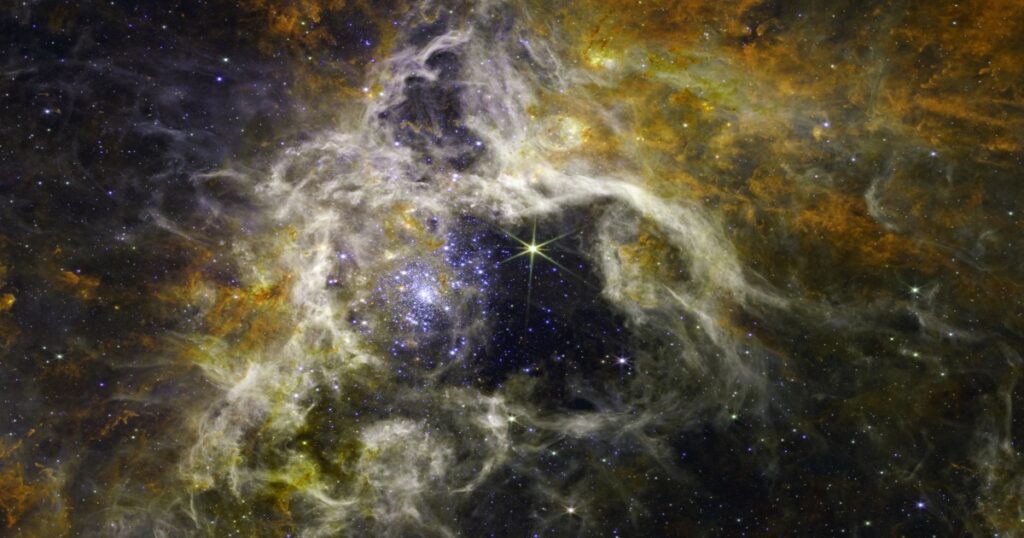
The Tarantula Nebula’s Key Points:
Cosmic Maelstrom: The Tarantula Nebula’s most striking feature is its sheer size and chaotic beauty. It’s a turbulent maelstrom of gas, dust, and young, hot stars, actively forming new stars at an incredible pace.
A Stellar Factory: The Tarantula Nebula is home to numerous massive stars, including some of the most luminous stars known. The intense radiation and stellar winds from these stars sculpt the surrounding gas and dust, triggering further star formation in a continuous cycle.
A Violent Symphony: The starburst activity within the Tarantula Nebula creates a violent and energetic environment. Supernovae explode, stellar winds rage, and new stars ignite, showcasing the raw power of stellar birth and evolution.
The Tarantula Nebula’s Discovery:
Likely observed by early astronomers due to its brightness, but the first documented recognition is attributed to French explorer and astronomer Frederick de Houtman in 1603, who included it in his celestial charts of the southern hemisphere.
The Tarantula Nebula’s Distance from Earth:
The Tarantula Nebula is roughly 165,000 light-years away from Earth, residing in the Large Magellanic Cloud, a satellite galaxy of our Milky Way.
The Tarantula Nebula’s Size:
The Tarantula Nebula is a colossal nebula, stretching roughly 1,800 light-years in diameter, dwarfing most nebulae in our own galaxy.
The Tarantula Nebula’s Formation:
The Tarantula Nebula likely formed from the collapse of a giant molecular cloud within the Large Magellanic Cloud. The sheer size and density of this cloud allowed for the formation of numerous massive stars, which in turn triggered a chain reaction of further star formation through shockwaves and stellar winds.
The Tarantula Nebula’s Iconic Feature:
The Tarantula Nebula’s sheer size, chaotic structure, and vibrant colors showcasing the ongoing starburst activity, particularly evident in long-exposure astrophotography.
The Tarantula Nebula’s Popularity:
Due to its distance, the Tarantula Nebula isn’t visible to the naked eye from Earth. However, its immense size, violent star formation, and location within a neighboring galaxy make it a popular target for professional astronomers using powerful telescopes.
The Tarantula Nebula’s Recent Developments:
Advanced telescopes like Hubble and Spitzer are providing astronomers with unprecedented views of the Tarantula Nebula. Studies delve into the birth and evolution of massive stars, the impact of stellar winds and supernovae on the surrounding environment, and the potential for future generations of stars within this dynamic nebula.
24. The Orion Nebula:
The Orion Nebula (Messier 42, M42, NGC 1976) is a renowned and captivating emission nebula, a glittering jewel box of gas and dust nestled within the mighty constellation Orion, the Hunter.

The Orion Nebula’s Key Points:
Cosmic Jewel Box: The Orion Nebula’s most striking feature is its intricate tapestry of glowing gas and dust clouds. The four brightest stars of the Trapezium Cluster dominate the central region, surrounded by wispy tendrils, pillars, and nebulae sculpted by energetic radiation and stellar winds.
A Stellar Cradle: The Orion Nebula is home to a vibrant young open cluster known as the Trapezium Cluster, which contains several hot, massive stars. The intense ultraviolet light from these stars excites the surrounding hydrogen gas, causing it to emit a characteristic blue-green glow.
A Sculpted Symphony: The Orion Nebula’s intricate structures are a testament to the interplay between gas, dust, and young stars. Stellar winds and radiation carve out cavities within the nebula, while denser regions collapse under their own gravity, giving birth to new stars – a continuous cycle of creation and destruction.
The Orion Nebula’s Discovery:
The Orion Nebula is one of the earliest documented nebulae, likely observed by civilizations around the world for millennia. The first written record of its recognition is attributed to Greek astronomer Aristotle in 340 BC.
The Orion Nebula’s Distance from Earth:
The Orion Nebula is approximately 1,344 light-years away from Earth, residing in the constellation Orion in our Milky Way Galaxy.
The Orion Nebula’s Size:
The Orion Nebula is a vast nebula, stretching roughly 24 light-years across.
The Orion Nebula’s Formation:
The Orion Nebula likely formed from the collapse of a giant molecular cloud, a vast region of gas and dust in space. As the cloud collapsed under its own gravity, denser regions within it ignited nuclear fusion, becoming the stars of the Trapezium Cluster. The intense radiation and winds from these young stars then interacted with the remaining dust and gas, creating the emission nebula we see today.
The Orion Nebula’s Iconic Feature:
The intricate tapestry of glowing gas and dust clouds, with the prominent Trapezium Cluster at its heart, particularly evident in long-exposure astrophotography. The iconic Pillars of Creation are a fascinating sub-feature within the Orion Nebula.
The Orion Nebula’s Popularity:
Due to its relative brightness and association with the constellation Orion, the Orion Nebula is one of the most popular targets for both professional astronomers and amateur astrophotographers. It offers a captivating glimpse into the birth of stars and the dynamic processes at play within a stellar nursery.
The Orion Nebula’s Recent Developments:
Advanced telescopes like Hubble continue to reveal details about Orion Nebula’s intricate dust structures and the ongoing birth of new stars within its gaseous cradle.
The Orion Nebula’s Bonus Note:
The Orion Nebula is a popular subject in astronomy education and outreach programs due to its beauty and relative ease of observation with binoculars or small telescopes. It serves as a gateway for many to explore the wonders of the universe and the ongoing cycle of star birth and evolution.
25. The Crab Nebula:
The Crab Nebula (Messier 1, M1, NGC 1952) is a supernova remnant, the leftover glowing debris field following the spectacular explosion of a massive star.

The Crab Nebula’s Key Points:
Cosmic Castaway: The Crab Nebula’s most striking feature is its filamentary structure, the expanding shockwave from the supernova that ripped through the surrounding gas and dust. This filamentary network glows brightly, showcasing the energetic aftermath of the stellar explosion.
A Pulsar’s Powerhouse: The true heart of the Crab Nebula lies hidden within its wispy tendrils – a rapidly spinning neutron star, the collapsed core of the exploded star. This pulsar powers the nebula’s glow by emitting beams of radiation that sweep across the surrounding gas.
A Celestial Timekeeper: The Crab Nebula is a young supernova remnant, its expansion precisely measured by astronomers. This allows them to pinpoint the date of the original supernova explosion, estimated to have occurred in 1054 AD, and use it as a benchmark for understanding stellar evolution and supernovae.
The Crab Nebula’s Discovery:
The supernova that created the Crab Nebula was a recorded astronomical event. Chinese and Korean astronomers documented the appearance of a “guest star” in the constellation Taurus in 1054 AD, which faded over several months. The glowing remnant, the Crab Nebula, was identified much later by English physician John Bevis in the mid-18th century.
The Crab Nebula’s Distance from Earth:
The Crab Nebula is roughly 6,500 light-years away from Earth, residing in the constellation Taurus (the Bull) in our Milky Way Galaxy.
The Crab Nebula’s Size:
The Crab Nebula itself is constantly expanding, currently stretching roughly 11 light-years in diameter.
The Crab Nebula’s Formation:
The Crab Nebula formed following the core collapse and explosive death of a massive star. The star’s outer layers were ejected into space as a supernova, while the remaining core imploded under its own gravity, becoming a super-dense neutron star. The shockwave from the explosion and the ongoing energy input from the pulsar shaped the nebula and continue to power its glow.
The Crab Nebula’s Iconic Feature:
The Crab Nebula is the filamentary structure of glowing gas and dust, the expanding aftermath of the supernova explosion, particularly evident in long-exposure astrophotography.
The Crab Nebula’s Popularity:
The Crab Nebula is a popular target for astronomers due to its unique nature as a young supernova remnant and its association with a well-documented historical supernova event. It offers valuable insights into the violent deaths of massive stars and the evolution of stellar remnants.
The Crab Nebula’s Recent Developments:
Advanced telescopes like Hubble and Chandra continue to provide astronomers with detailed observations of the Crab Nebula. Studies focus on the dynamics of the expanding gas, the properties of the central pulsar, and the ongoing impact of the supernova on the surrounding interstellar medium. The Crab Nebula serves as a natural laboratory for understanding the complex physical processes at play in supernovae and their aftermath.
26. The Butterfly Nebula:
The Butterfly Nebula (NGC 6302) is a bipolar planetary nebula, a glowing cloud of gas and dust expelled by a dying star in its final throes. The Butterfly Nebula’s unique, “hourglass” shape sets it apart from most other planetary nebulae.
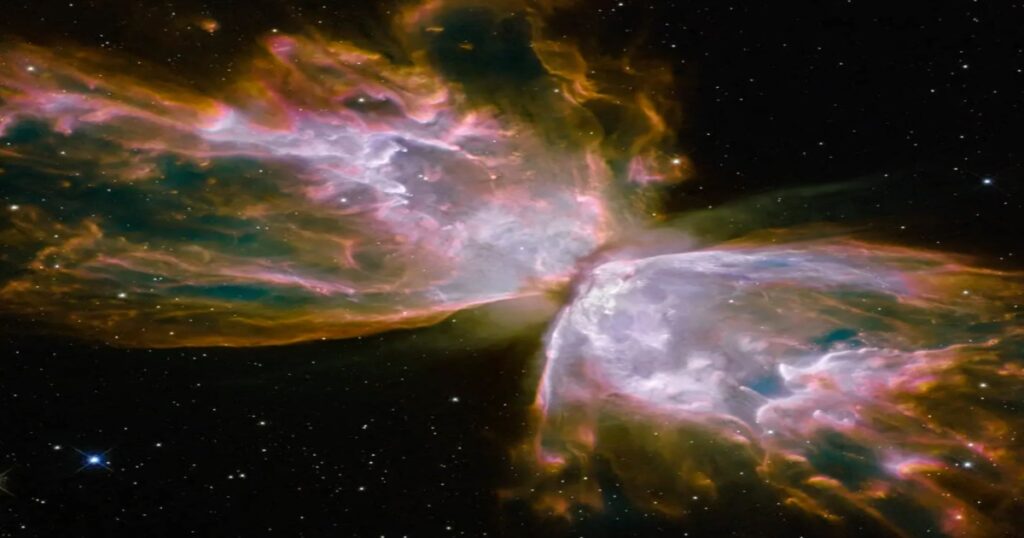
The Butterfly Nebula’s Key Points:
Cosmic Butterfly: The Butterfly Nebula’s most striking feature is its bipolar morphology, resembling a butterfly with outstretched wings. This shape is sculpted by powerful stellar winds from the central star pushing against the surrounding gas and dust, creating a captivating display.
A Star’s Final Act: The Butterfly Nebula is a testament to the late stages of stellar evolution. As a star nears the end of its life on the main sequence, it sheds its outer layers, forming a planetary nebula. The Butterfly Nebula showcases this process in a visually stunning way.
A Sculpted Symphony: The intricate bipolar structure of the Butterfly Nebula isn’t formed in a single event. The central star likely expelled its outer layers in multiple episodes, with the faster-moving gas forming the tips of the “wings” and the slower-moving gas forming the central region.
The Butterfly Nebula’s Discovery:
The Butterfly Nebula’s existence was likely noted by early astronomers due to its faint nebulosity. However, its first documented recognition is attributed to German astronomer Wilhelm Herschel in 1782.
The Butterfly Nebula’s Distance from Earth:
The Butterfly Nebula is roughly 3,392 light-years away from Earth, residing in the constellation Scorpius (the Scorpion) in our Milky Way Galaxy.
The Butterfly Nebula’s Size:
The Butterfly Nebula is a relatively small nebula compared to giants like the Orion Nebula, with a diameter of roughly 1.5 light-years.
The Butterfly Nebula’s Formation:
The Butterfly Nebula formed as a dying, Sun-like star shed its outer layers. The intense radiation and stellar winds from the central star then sculpted the ejected gas and dust into the now-iconic bipolar lobes, creating the “butterfly” shape.
The Butterfly Nebula’s Iconic Feature:
The Butterfly Nebula’s distinct “hourglass” or “butterfly” morphology, with two prominent lobes emanating from a central star, particularly evident in long-exposure astrophotography. The contrasting colors within the lobes add to its captivating appearance.
The Butterfly Nebula’s Popularity:
Due to its unique shape and relatively faint nature, the Butterfly Nebula isn’t readily visible to the naked eye. However, its captivating beauty makes it a popular target for amateur astronomers with good telescopes and astrophotographers seeking to capture its delicate details.
The Butterfly Nebula’s Recent Developments:
Advanced telescopes like Hubble have provided astronomers with detailed observations of the Butterfly Nebula’s structure, composition, and dynamics. Studies explore the sculpting power of the stellar winds, the ongoing expansion of the lobes, and the potential for future planetary nebulae formation from the ejected material.
27. The Blue Snowball Nebula:
The Blue Snowball Nebula (NGC 7027) is a captivating planetary nebula, a glowing cloud of gas and dust ejected by a dying star in its final throes offering a glimpse into the final act of a Sun-like star. The Blue Snowball Nebula’s striking blue color and spherical shape make it a fascinating object of study.

The Blue Snowball Nebula’s Key Points:
Cosmic Snowball: The Blue Snowball Nebula’s most striking feature is its resemblance to a giant, bright blue snowball. The expelled gas and dust from the central star have formed a roughly spherical shell, earning its nickname. The intense blue hue originates from the hot, ionized oxygen within the nebula.
A Star’s Transformation: The Blue Snowball Nebula showcases the dramatic transformation that occurs during the final stages of a star’s life. As a Sun-like star exhausts its fuel, it throws off its outer layers, forming a planetary nebula. The Blue Snowball Nebula captures this process in a beautiful and relatively young example.
A Celestial Enigma: Despite extensive study, the exact formation process and structure of the Blue Snowball Nebula remain somewhat enigmatic. The uniform spherical shell is uncommon in planetary nebulae, and astronomers continue to unravel the mechanisms that shaped it.
The Blue Snowball Nebula’s Discovery:
The Blue Snowball Nebula was discovered on October 6, 1784, by the renowned astronomer William Herschel, making it one of the earliest documented planetary nebulae.
The Blue Snowball Nebula’s Distance from Earth:
The Blue Snowball Nebula is estimated to be roughly 1,400 light-years away from Earth, residing in the constellation Lacerta (the Lizard) in our Milky Way Galaxy.
The Blue Snowball Nebula’s Size:
The Blue Snowball Nebula is a relatively small nebula compared to giants like the Orion Nebula, with a diameter of roughly 0.7 light-years.
The Blue Snowball Nebula’s Formation:
The Blue Snowball Nebula formed as a Sun-like star shed its outer layers. The intense radiation and stellar winds from the central star then sculpted the ejected gas and dust into a relatively uniform spherical shell, creating the “snowball” shape. However, the exact mechanism behind this uniform shell formation remains a topic of ongoing research.
The Blue Snowball Nebula’s Iconic Feature:
The Blue Snowball Nebula’s striking blue color and the near-spherical shape resembling a giant snowball, particularly evident in long-exposure astrophotography. The uniform shell and the contrast between the blue gas and the darker dust lanes within the nebula are of particular interest to astronomers.
The Blue Snowball Nebula’s Popularity:
Due to its relatively faint nature, the Blue Snowball Nebula isn’t readily visible to the naked eye. However, its captivating form and color make it a popular target for amateur astronomers with good telescopes and astrophotographers seeking to capture its unique details.
The Blue Snowball Nebula’s Recent Developments:
Advanced telescopes like Hubble and Spitzer are providing astronomers with ever-more detailed observations of the Blue Snowball Nebula. Studies focus on the composition and dynamics of the gas within the shell, the nature of the central star, and the ongoing expansion of the nebula. The unusual spherical form continues to be a point of investigation, with astronomers exploring various possibilities for its creation. The Blue Snowball Nebula serves as a valuable example for understanding the diverse morphologies and processes at play during the planetary nebula stage of stellar evolution.
28. The Monkey Head Nebula:
The Monkey Head Nebula (NGC 2174) is an emission nebula that boasts a captivating shape that ignites the imagination, making it a popular target for astronomers and space enthusiasts alike.
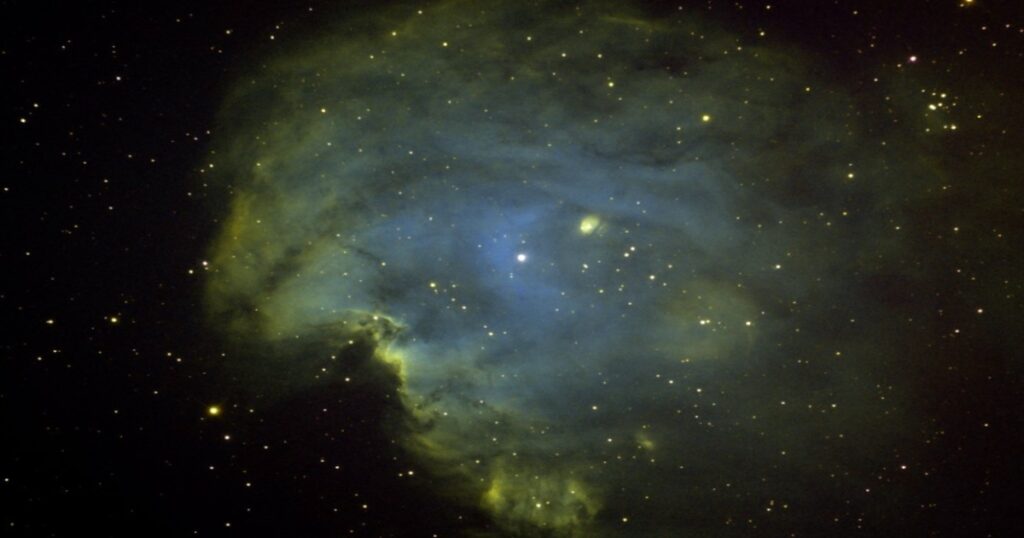
The Monkey Head Nebula’s Key Points:
Cosmic Monkey: The Monkey Head Nebula’s most striking feature is its uncanny resemblance to a monkey’s head, complete with glowing “eyes” and a wispy “mane.” This playful shape is formed by the uneven distribution of gas and dust within the nebula, sculpted by the energetic winds and radiation from the newly born stars.
A Stellar Cradle: The Monkey Head Nebula is home to a vibrant young open cluster of stars known as NGC 2175. The intense ultraviolet light from these massive stars energizes the surrounding hydrogen gas, causing it to emit a characteristic blue-green glow and sculpting the nebula’s intricate features.
A Dynamic Dance: The Monkey Head Nebula is a place of constant change. Newly formed stars unleash powerful winds and radiation, pushing back against the surrounding gas and dust. This dynamic interplay creates the nebula’s intricate structures and fuels the birth of future generations of stars.
The Monkey Head Nebula’s Discovery:
The nebula’s existence was likely noted by early astronomers due to its faint nebulosity. However, its first documented recognition as a distinct nebula is attributed to English astronomer John Herschel in the early 1800s.
The Monkey Head Nebula’s Distance from Earth:
The Monkey Head Nebula is roughly 6,400 light-years away from Earth, residing in the mighty constellation Orion (the Hunter) in our Milky Way Galaxy.
The Monkey Head Nebula’s Size:
The Monkey Head Nebula is a vast nebula, stretching roughly 30 arcminutes across, equivalent to a diameter of about 40 light-years at its estimated distance.
The Monkey Head Nebula’s Formation:
The Monkey Head Nebula likely formed from the collapse of a giant molecular cloud within the Orion Molecular Cloud Complex. As the cloud collapsed under its own gravity, denser regions within it ignited nuclear fusion, becoming the stars of the embedded cluster NGC 2175. The intense radiation and winds from these young stars then interacted with the remaining dust and gas, creating the emission nebula we see today.
The Monkey Head Nebula’s Iconic Feature:
The Monkey Head Nebula’s unmistakable monkey-shaped head with glowing “eyes” and a wispy “mane,” particularly evident in long-exposure astrophotography. The intricate interplay of gas and dust sculpted by the energetic young stars within the nebula adds to its captivating appearance.
The Monkey Head Nebula’s Popularity:
Due to its relative brightness within the Orion constellation and its intriguing shape, the Monkey Head Nebula is a popular target for both professional astronomers and amateur astrophotographers. It offers a captivating glimpse into the birth of stars and the dynamic processes at play within a stellar nursery.
The Monkey Head Nebula’s Bonus Note:
The Monkey Head Nebula’s playful form makes it a favorite among astronomy enthusiasts, sparking imaginations and igniting a sense of wonder about the universe’s star-forming regions. It serves as a reminder of the diverse shapes and processes that occur within nebulae as they give birth to new stars.
29. The Barn Owl Nebula:
The Barn Owl Nebula (NGC 3199) is a reflection nebula, a cloud of dust that reflects the light from nearby stars, showcasing a dusky silhouette against the starry backdrop. The Barn Owl Nebula’s uncanny resemblance to a barn owl’s face makes it a captivating celestial oddity.

The Barn Owl Nebula’s Key Points:
Cosmic Barn Owl: The Barn Owl Nebula’s most striking feature is its remarkable likeness to a barn owl’s face. The dark dust clouds obscure the light from background stars, creating the dark “eyes” and the surrounding “face” region, while the light from a nearby star (5 Vulpeculae) illuminates the “chest” area, completing the illusion.
A Master of Deception: The Barn Owl Nebula doesn’t emit its own light. Instead, it reflects the light from a nearby hot, young star, effectively “painting” the dust clouds with borrowed light to create the owl-like silhouette.
A Sculpted Silhouette: The intricate details of the Barn Owl Nebula are a testament to the interplay between dust and light. Dense clumps of dust block starlight entirely, forming the dark regions, while thinner dust layers reflect starlight with varying degrees of efficiency, creating the subtle variations in brightness across the nebula.
The Barn Owl Nebula’s Discovery:
The Barn Owl Nebula’s existence was likely noted by early astronomers due to its location near the bright star 5 Vulpeculae. However, its recognition as a distinct reflection nebula is attributed to astronomer William Herschel in the late 18th century.
The Barn Owl Nebula’s Distance from Earth:
The Barn Owl Nebula is roughly 1,000 light-years away from Earth, residing in the constellation Vulpecula (the Fox) in our Milky Way Galaxy.
The Barn Owl Nebula’s Size:
The Barn Owl Nebula is a relatively small nebula compared to giants like the Orion Nebula, with a diameter of roughly 4.5 light-years.
The Barn Owl Nebula’s Formation:
The Barn Owl Nebula likely formed from the collapse of a giant molecular cloud within the Milky Way galaxy. The dust and gas from this cloud didn’t reach the critical mass necessary to ignite nuclear fusion and become a star. However, the cloud was sculpted by the powerful winds and radiation from nearby hot stars, particularly 5 Vulpeculae, creating the reflection nebula we see today.
The Barn Owl Nebula’s Iconic Feature:
The Barn Owl Nebula’s uncanny resemblance to a barn owl’s face, with dark “eyes” formed by obscuration and a brighter “chest” region reflecting light from the nearby star, particularly evident in long-exposure astrophotography. The intricate details within the dust cloud add to the captivating illusion.
The Barn Owl Nebula’s Popularity:
Due to its relatively faint nature and reliance on reflected light, the Barn Owl Nebula isn’t readily visible to the naked eye. However, its intriguing shape and connection to nearby stars make it a popular target for astrophotographers seeking to capture its delicate details.
The Barn Owl Nebula’s Recent Developments:
Advanced telescopes like Hubble are providing astronomers with ever-more detailed observations of the Barn Owl Nebula’s dust composition and structure. Studies delve into the formation processes of reflection nebulae, the impact of nearby stars on the dust clouds, and the potential for future star formation within the surrounding molecular cloud. The Barn Owl Nebula serves as a valuable example for understanding the interplay between dust and light in shaping the appearance of celestial objects.
30. The Boomerang Nebula:
The Boomerang Nebula (PSR B0104+61) is a bipolar planetary nebula, a glowing cloud of gas and dust expelled by a dying star in its final throes. The Boomerang Nebula boasts a unique, almost perfectly symmetrical hourglass shape, earning its nickname.
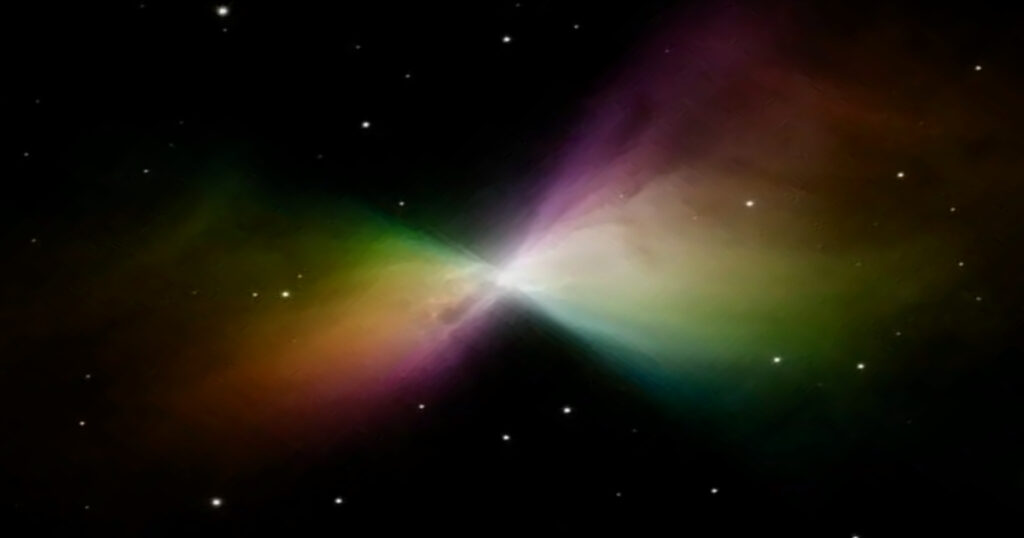
The Boomerang Nebula’s Key Points:
Cosmic Boomerang: The Boomerang Nebula’s most striking feature is its distinct bipolar morphology, resembling a boomerang with two lobes emanating from a central star. Powerful stellar winds from the central star push against the surrounding gas and dust, shaping it into this remarkable hourglass form.
A Star’s Final Act: The Boomerang Nebula is a testament to the late stages of stellar evolution. As a Sun-like star nears the end of its life on the main sequence, it sheds its outer layers, forming a planetary nebula. The Boomerang Nebula showcases this process in a visually stunning and remarkably symmetrical way.
A Sculpted Symphony: The intricate bipolar structure of the Boomerang Nebula isn’t formed in a single event. The central star likely expelled its outer layers in a series of pulses, with the faster-moving gas forming the tips of the “lobes” and the slower-moving gas forming the central region.
The Boomerang Nebula’s Discovery:
The Boomerang Nebula was discovered in 1980 by Australian astronomers using infrared observations, making it a relatively recent discovery compared to other nebulae.
The Boomerang Nebula’s Distance from Earth:
The Boomerang Nebula is roughly 5,000 light-years away from Earth, residing in the constellation Centaurus (the Centaur) in our Milky Way Galaxy.
The Boomerang Nebula’s Size:
The Boomerang Nebula is a relatively small nebula compared to giants like the Orion Nebula, with a total extent of roughly 1 light-year across.
The Boomerang Nebula’s Formation:
The Boomerang Nebula formed as a dying, Sun-like star shed its outer layers. The intense radiation and stellar winds from the central star then sculpted the ejected gas and dust into the now-iconic bipolar lobes, creating the “boomerang” shape.
The Boomerang Nebula’s Iconic Feature:
The Boomerang Nebula’s distinct “hourglass” or “boomerang” morphology, with two prominent lobes emanating from a central star, particularly evident in long-exposure astrophotography. The remarkable symmetry of the lobes is a captivating feature.
The Boomerang Nebula’s Popularity:
Due to its relatively faint nature, the Boomerang Nebula isn’t readily visible to the naked eye. However, its captivating shape and recent discovery make it a popular target for astronomers studying the late stages of stellar evolution and the sculpting power of stellar winds.
The Boomerang Nebula’s Recent Developments:
Advanced telescopes like Hubble and Spitzer are providing astronomers with ever-more detailed observations of the Boomerang Nebula’s structure, composition, and dynamics. Studies focus on the bipolar morphology, the ongoing expansion of the lobes, and the properties of the central star. The Boomerang Nebula serves as a valuable example for understanding the diverse shapes and processes at play during the planetary nebula stage of stellar evolution.
Conclusion:
Across the universe, nebulae shimmer in a breathtaking display of colors and shapes. These celestial clouds are nature’s nurseries, birthing stars, and sculpting intricate structures. From vast emission nebulae glowing with ionized gas to colorful reflection nebulae adorned by starlight, each type unveils a unique story. Supernova remnants, echoes of stellar explosions, stand as majestic testaments to a star’s fiery demise. Whether wispy tendrils or colossal pillars, nebulae never fail to ignite our imaginations, reminding us of the universe’s artistry and the awe-inspiring power of creation.
